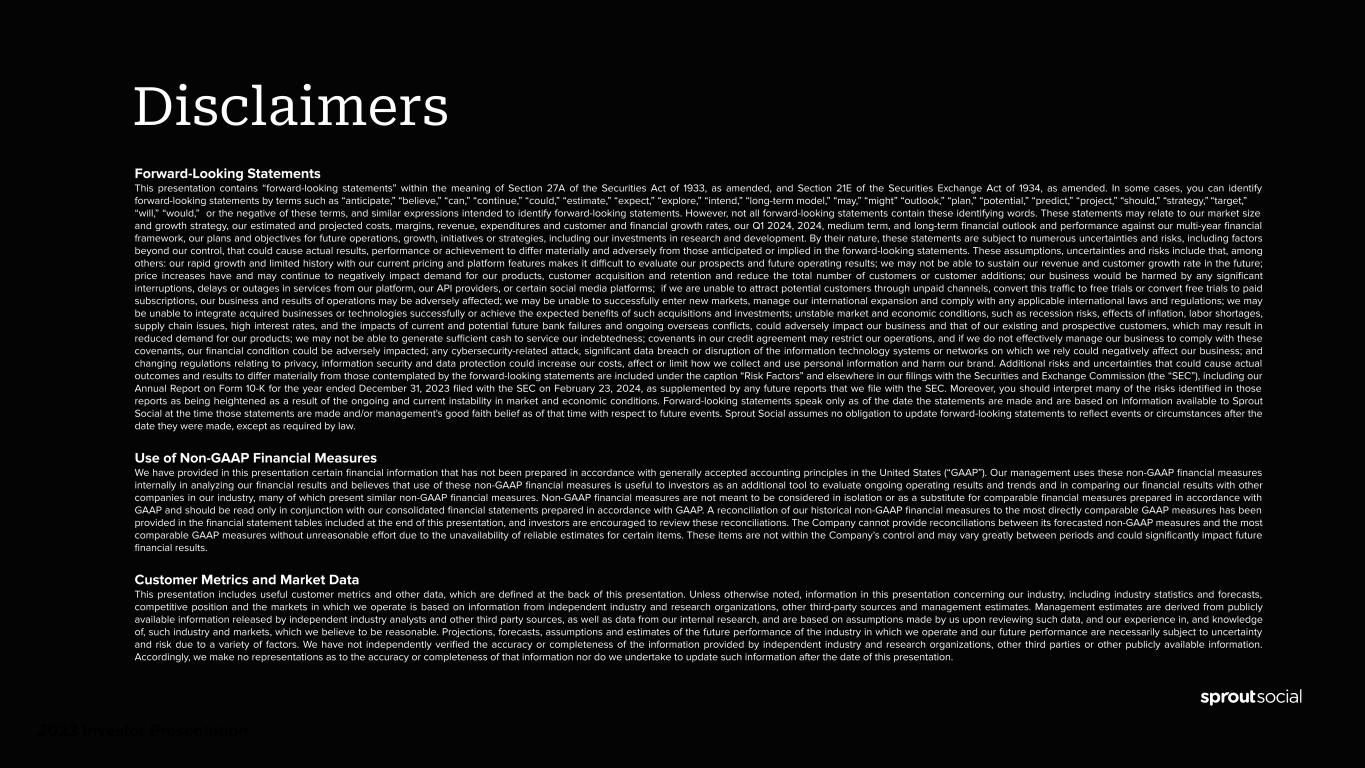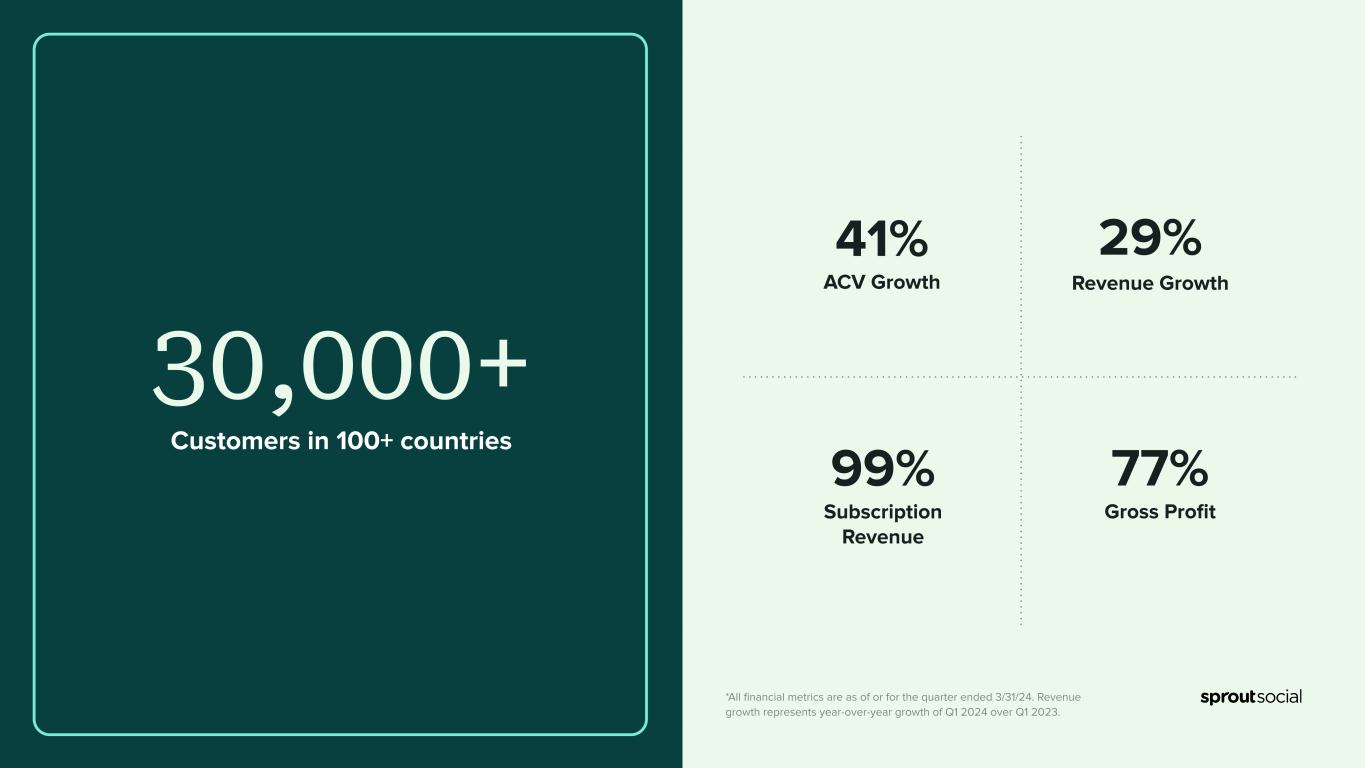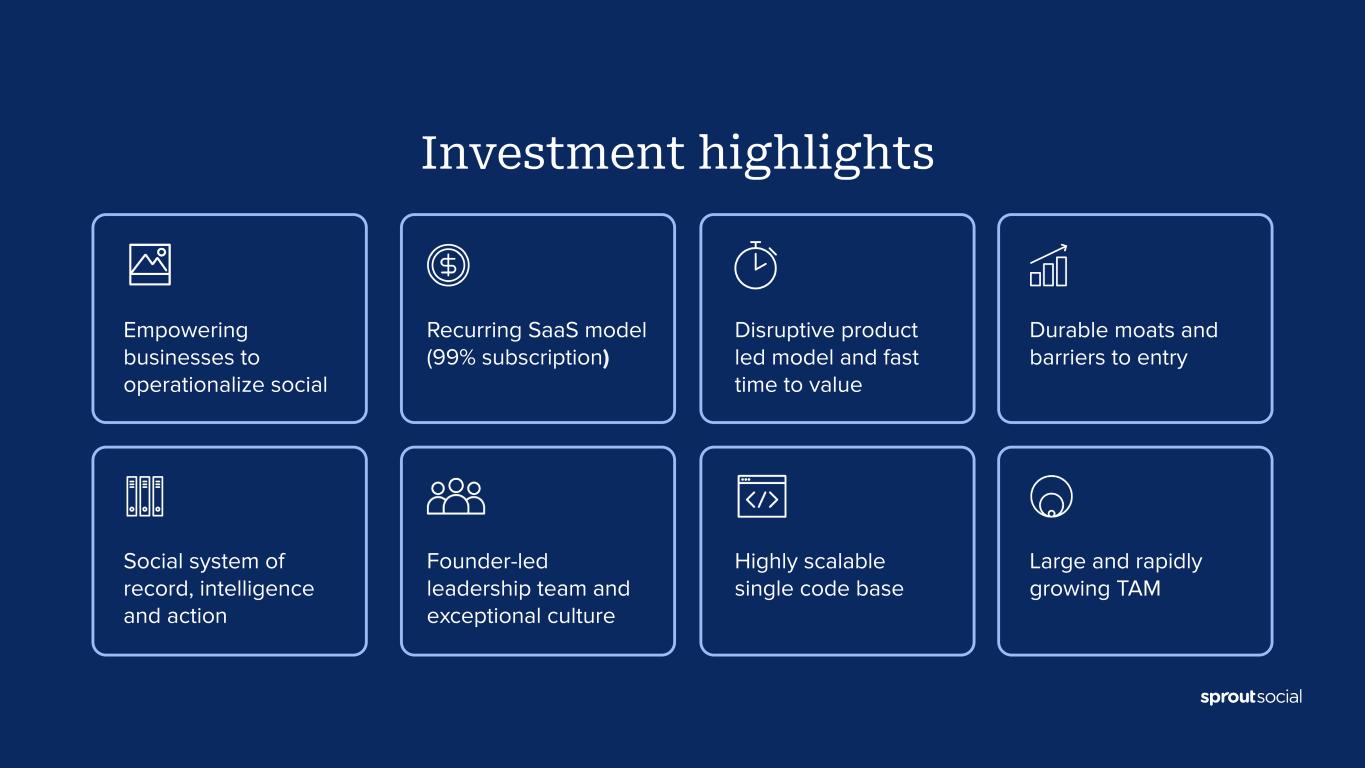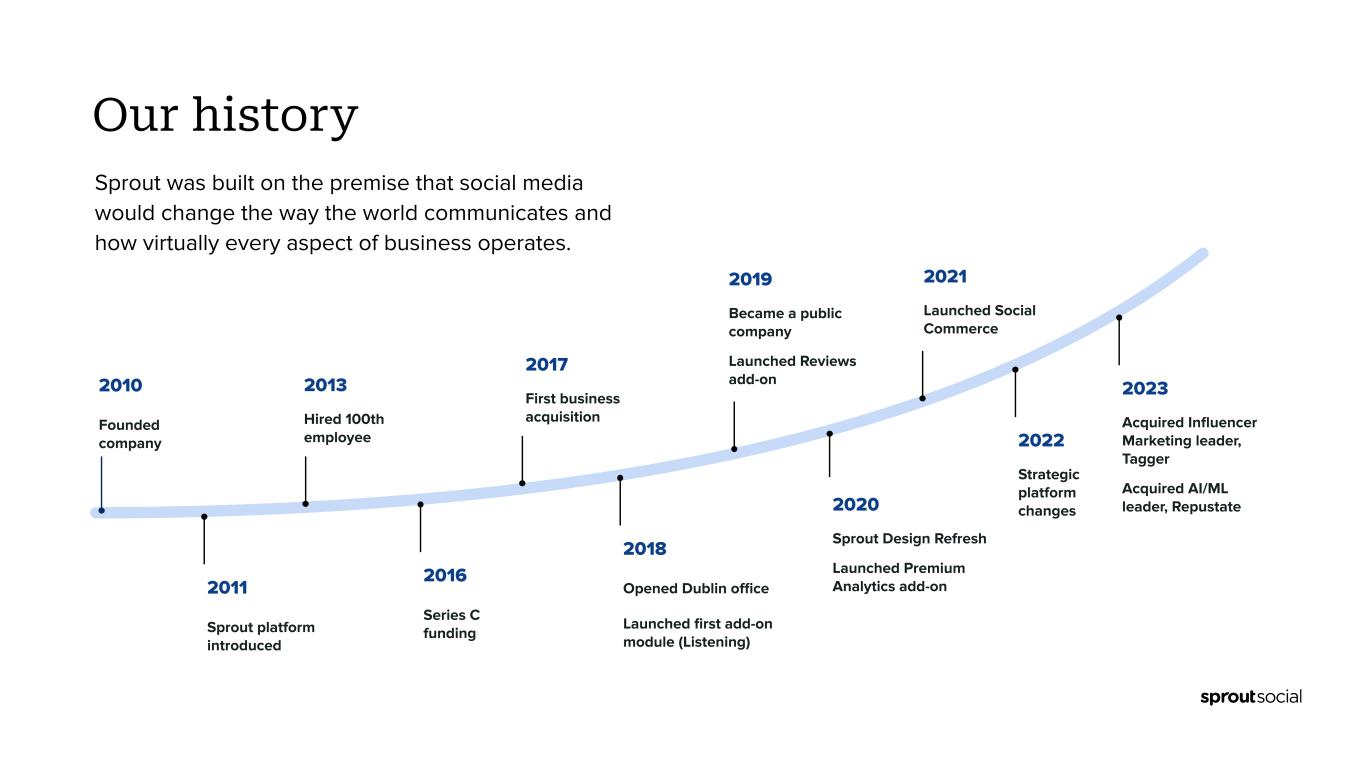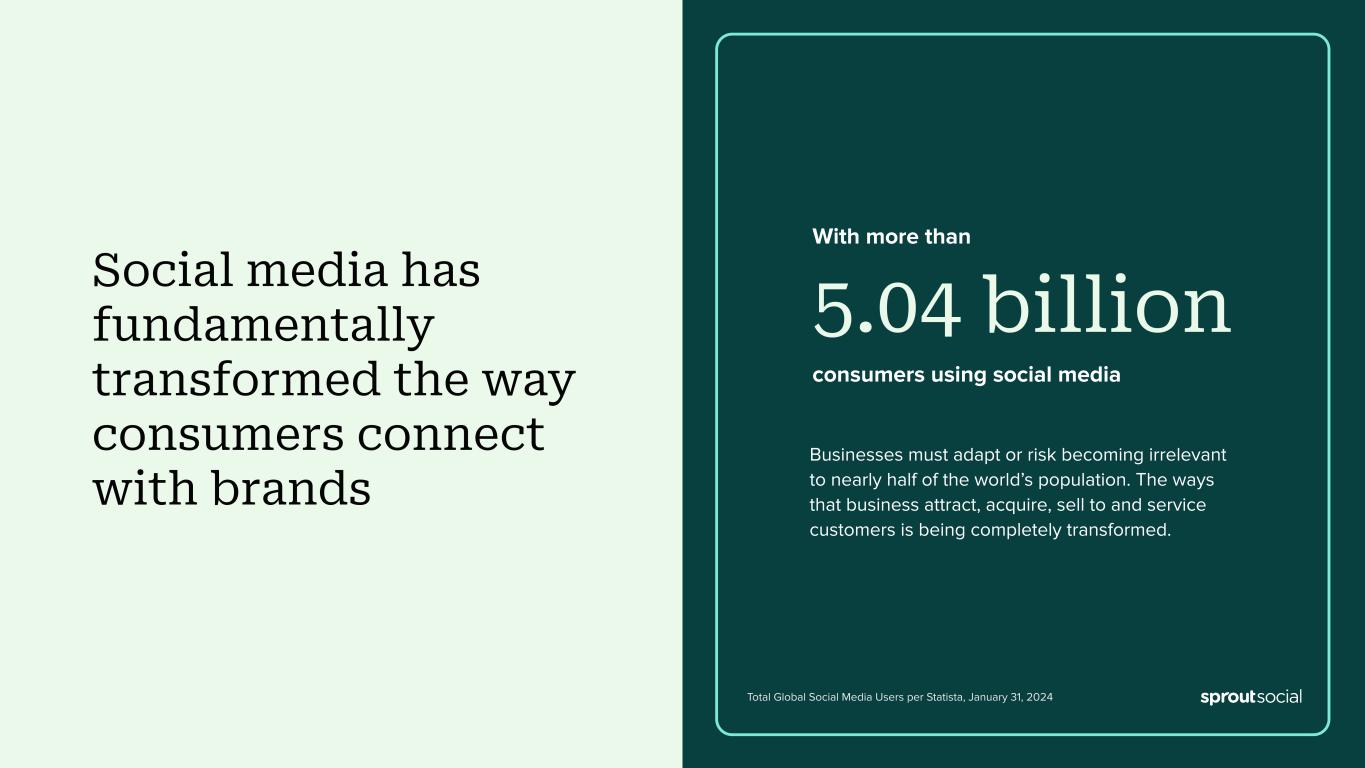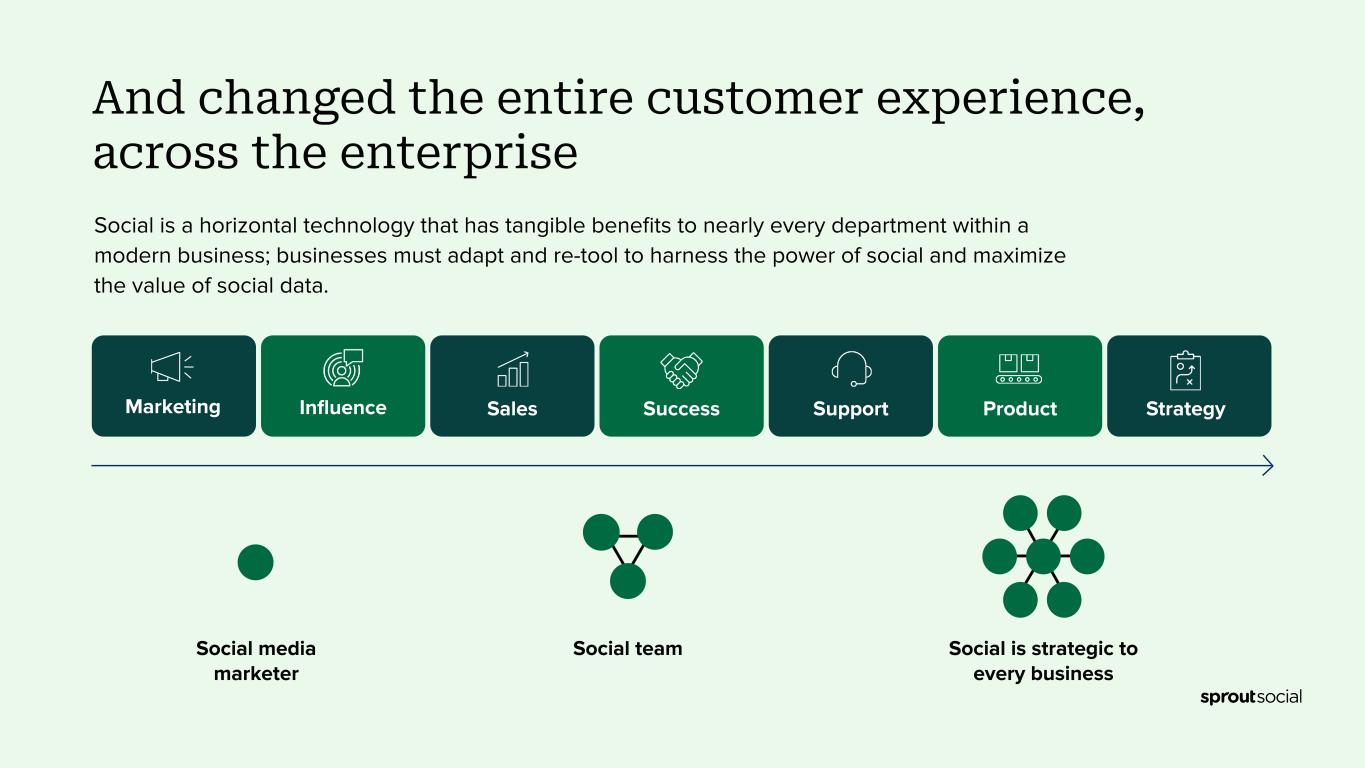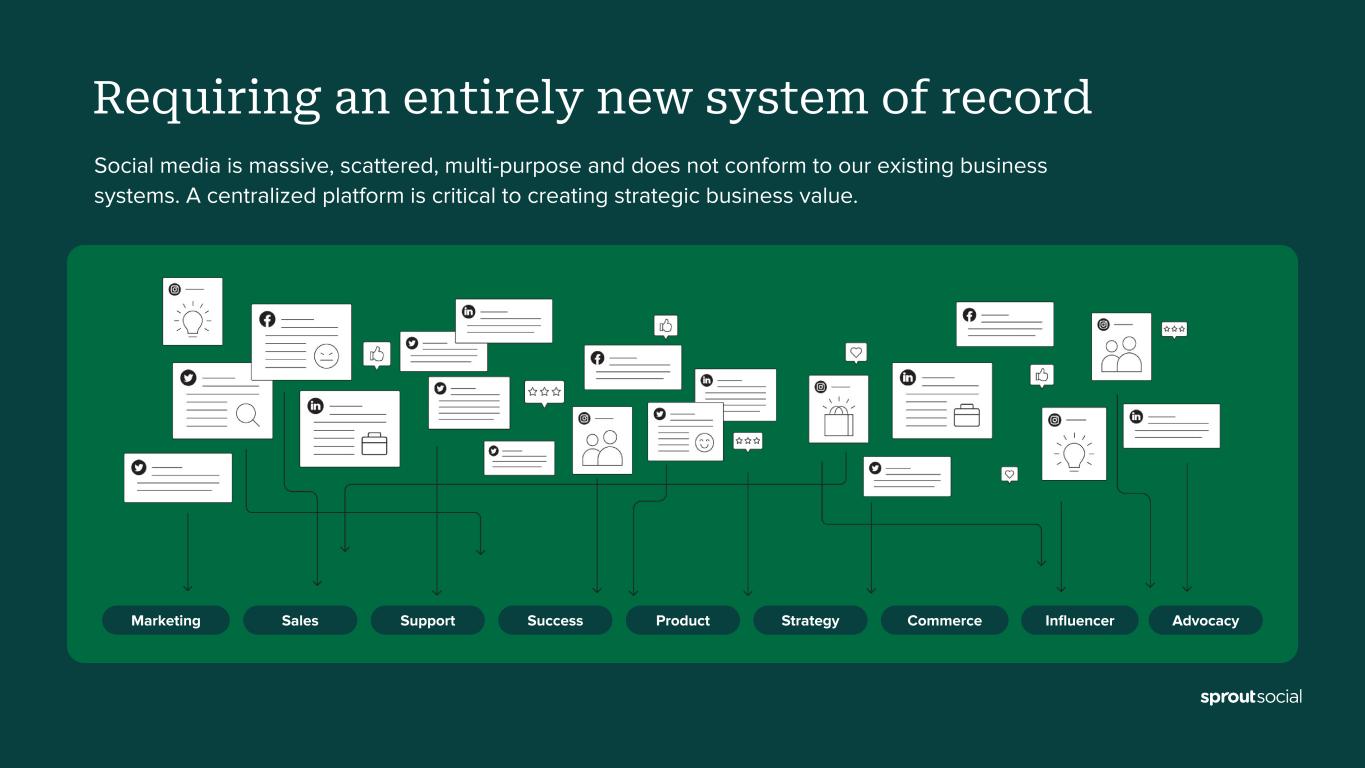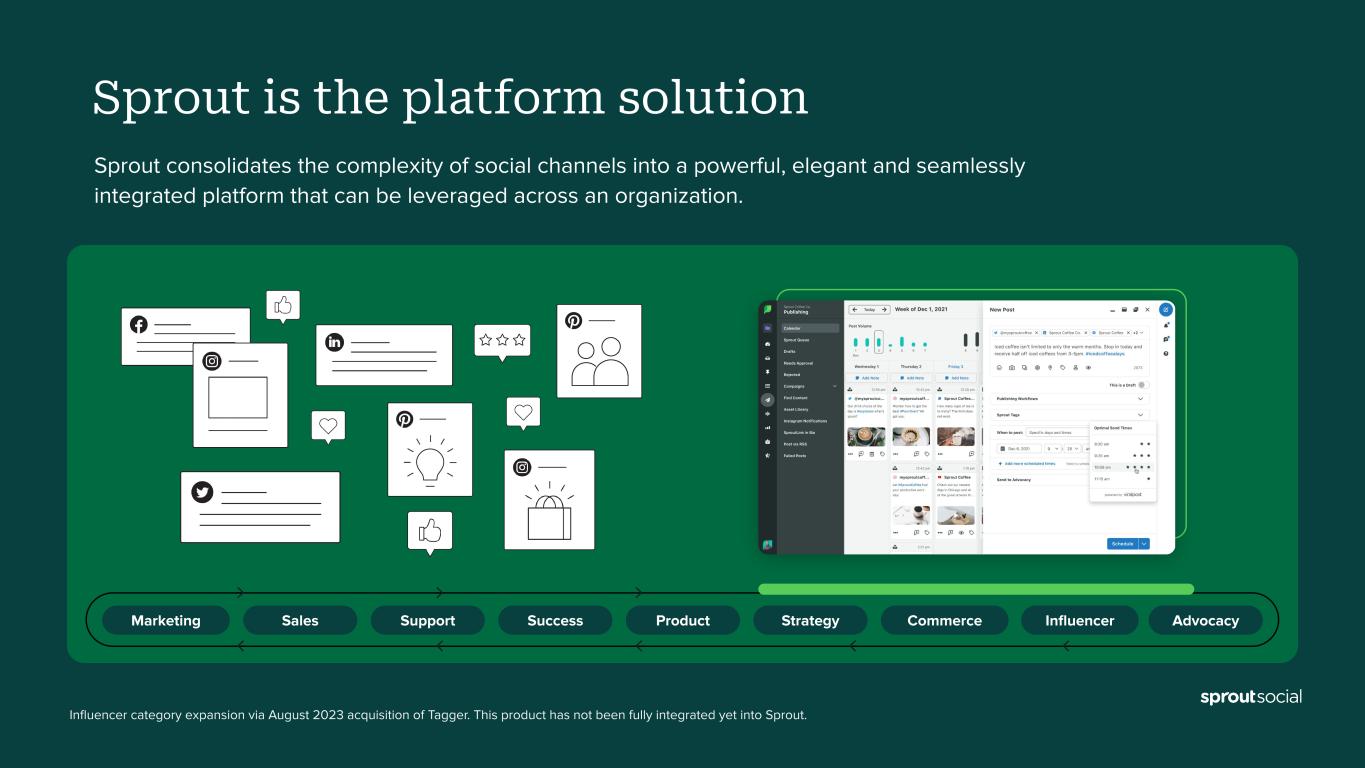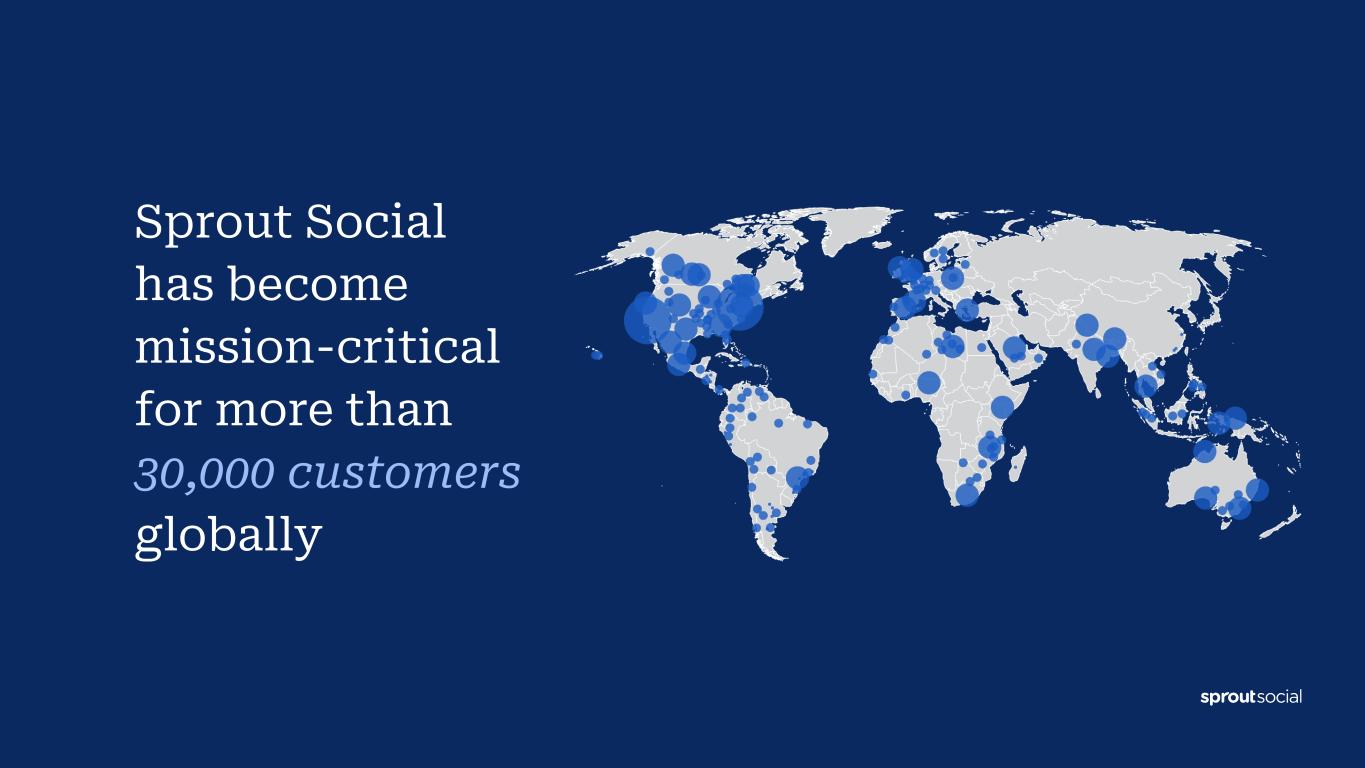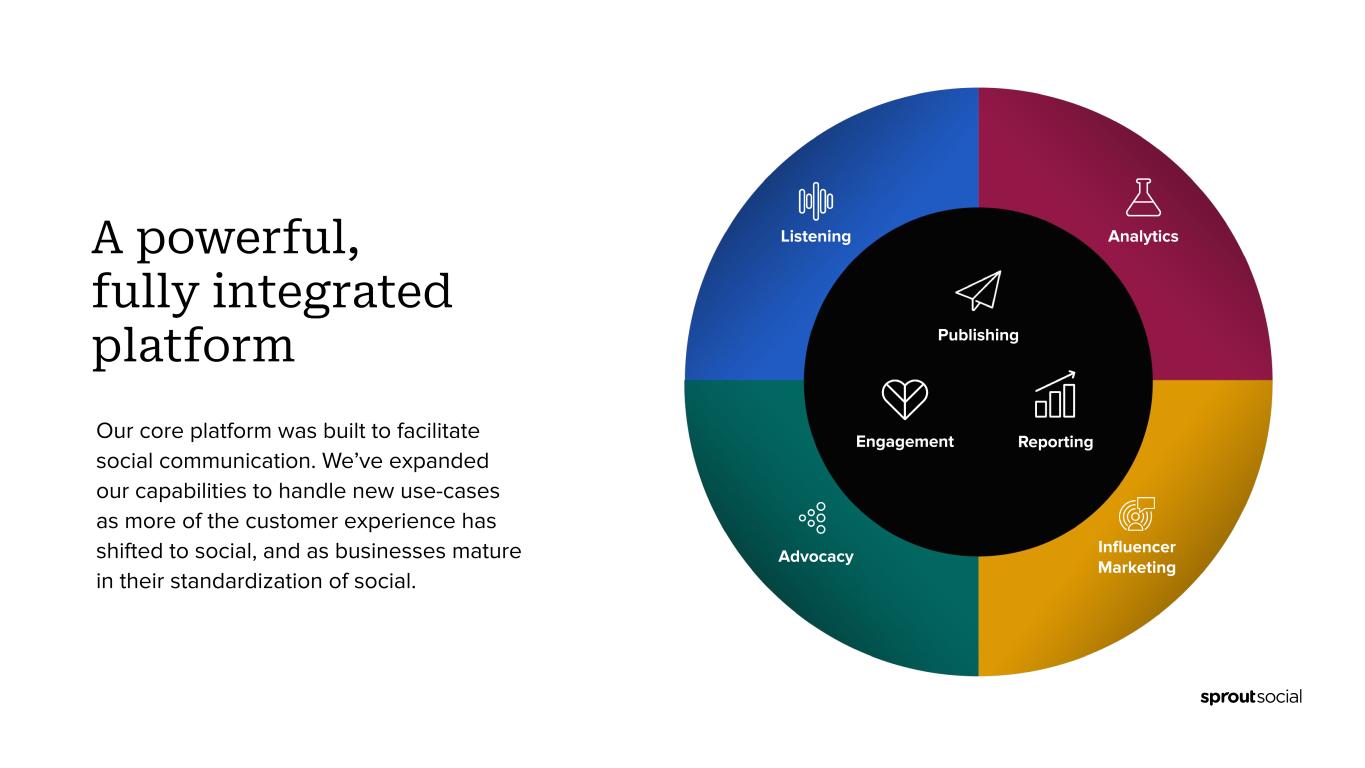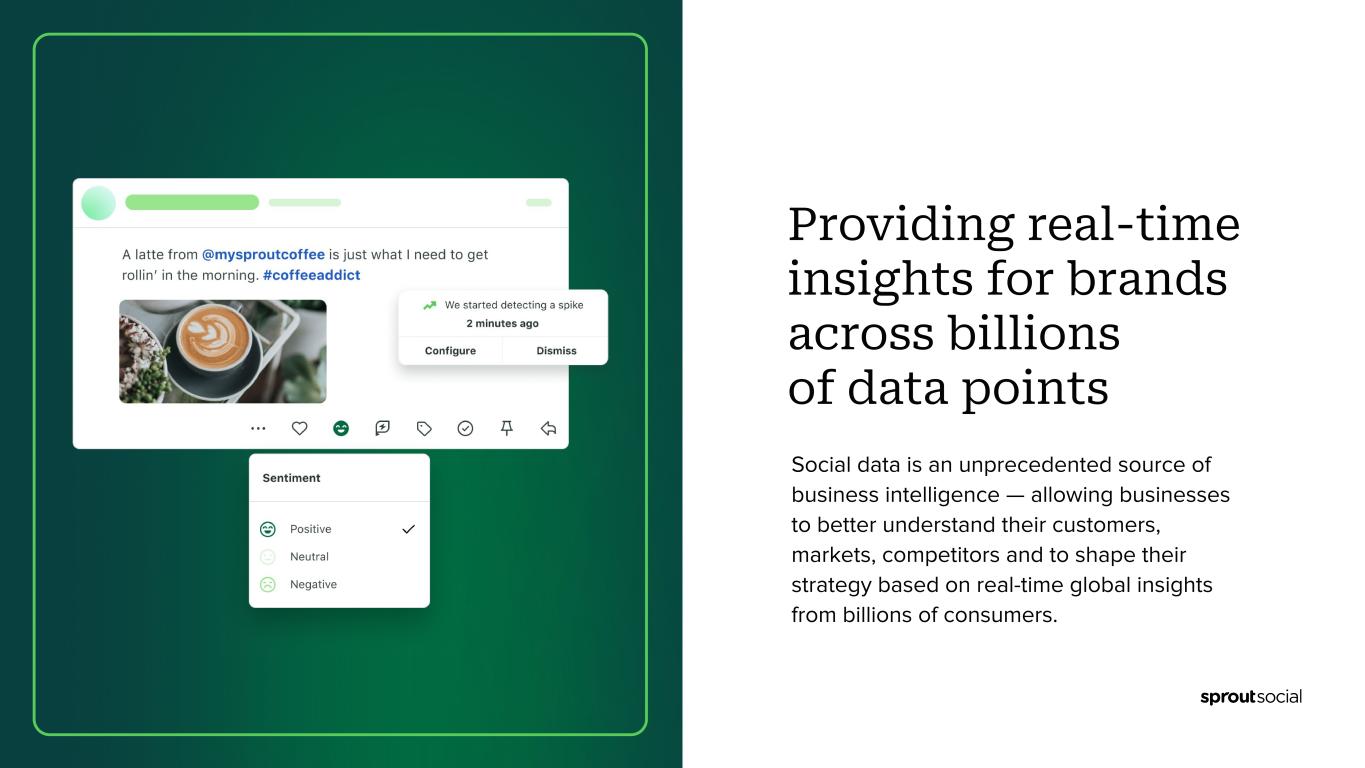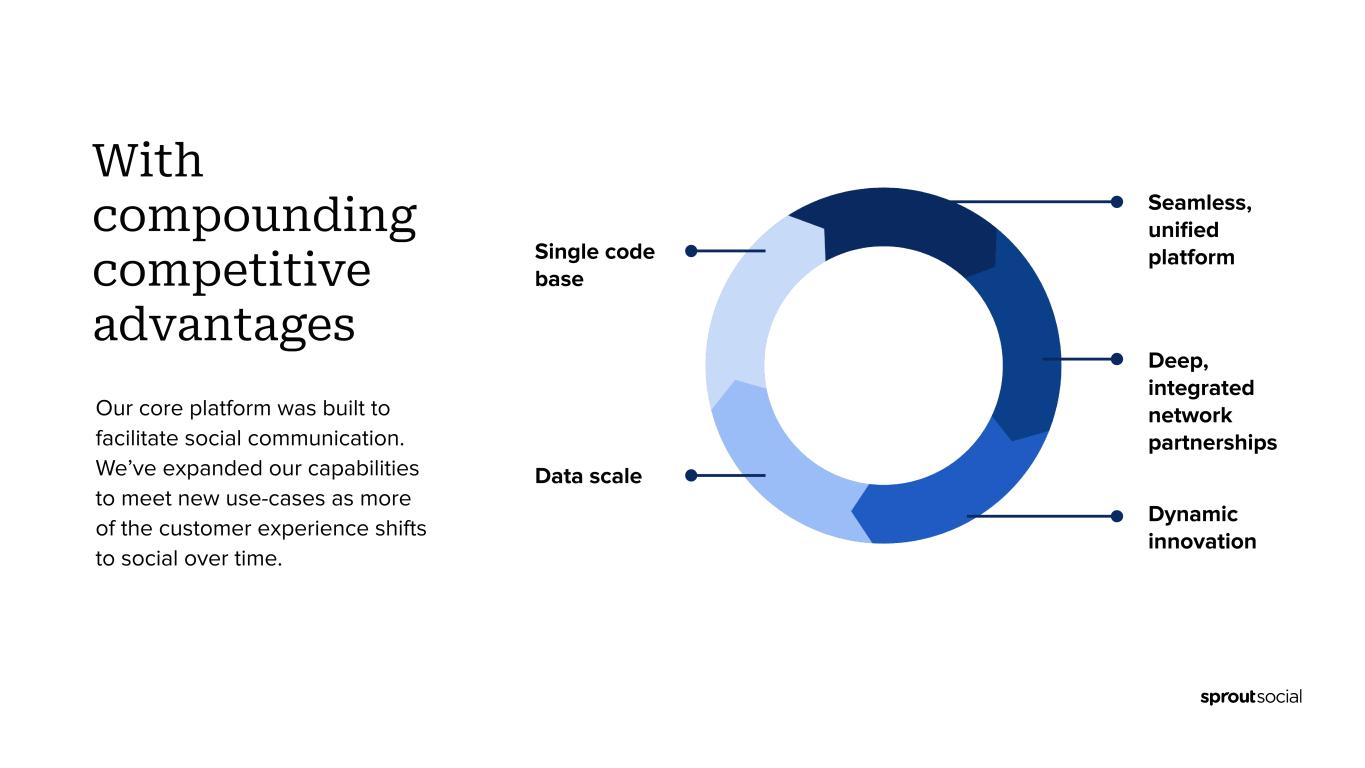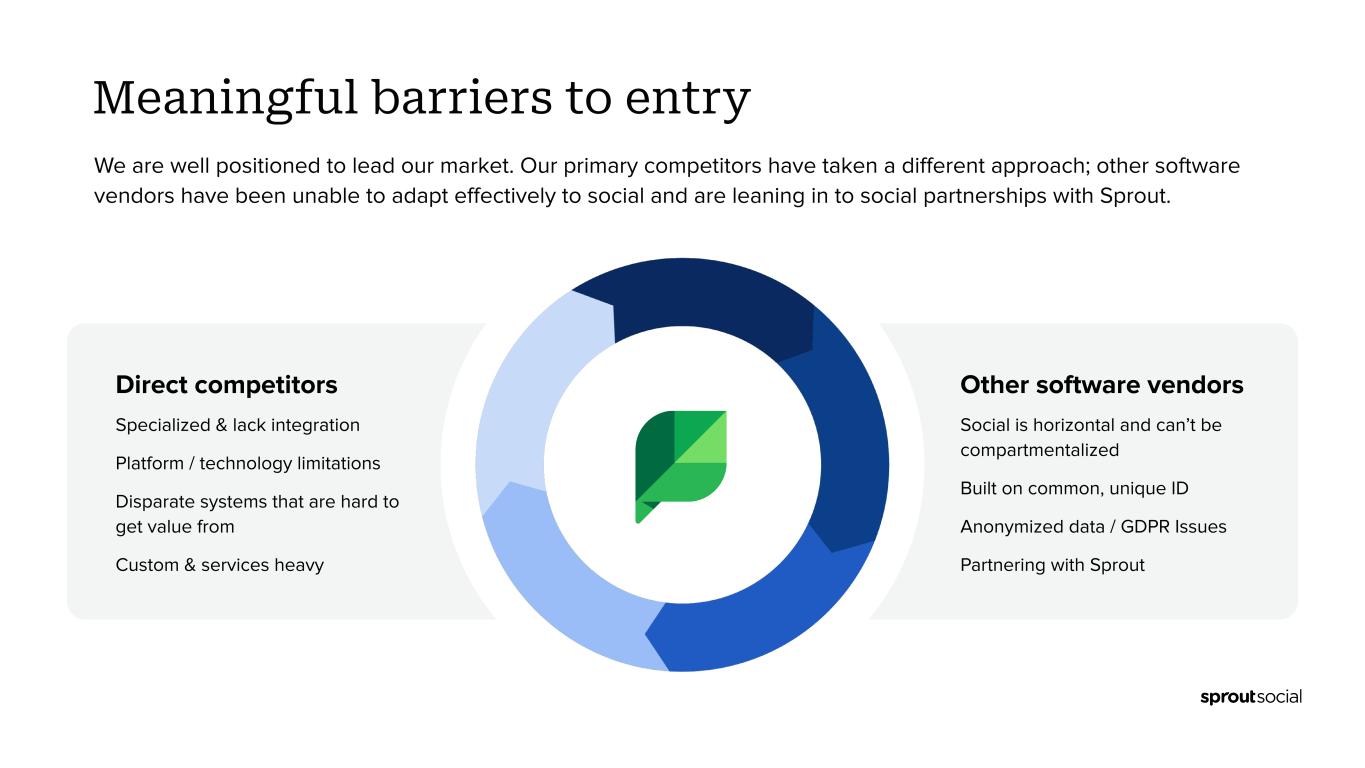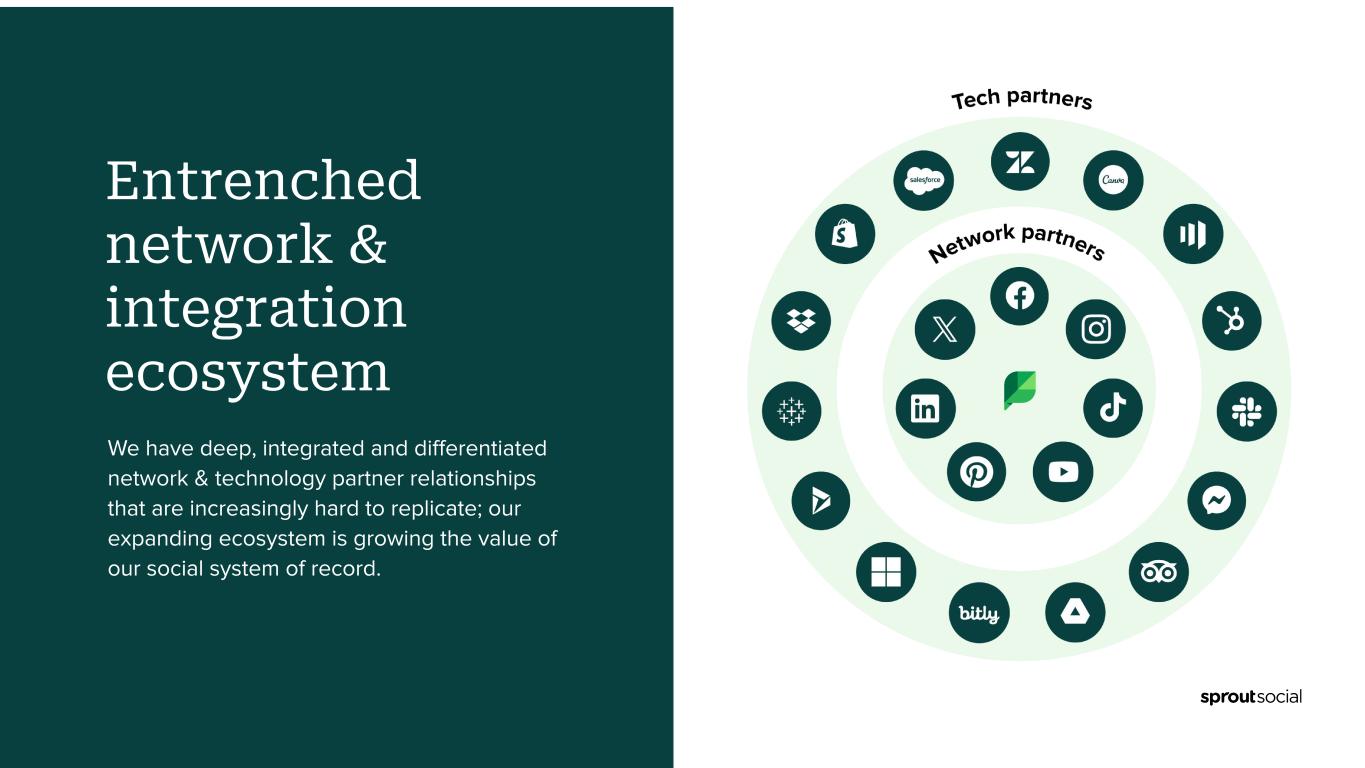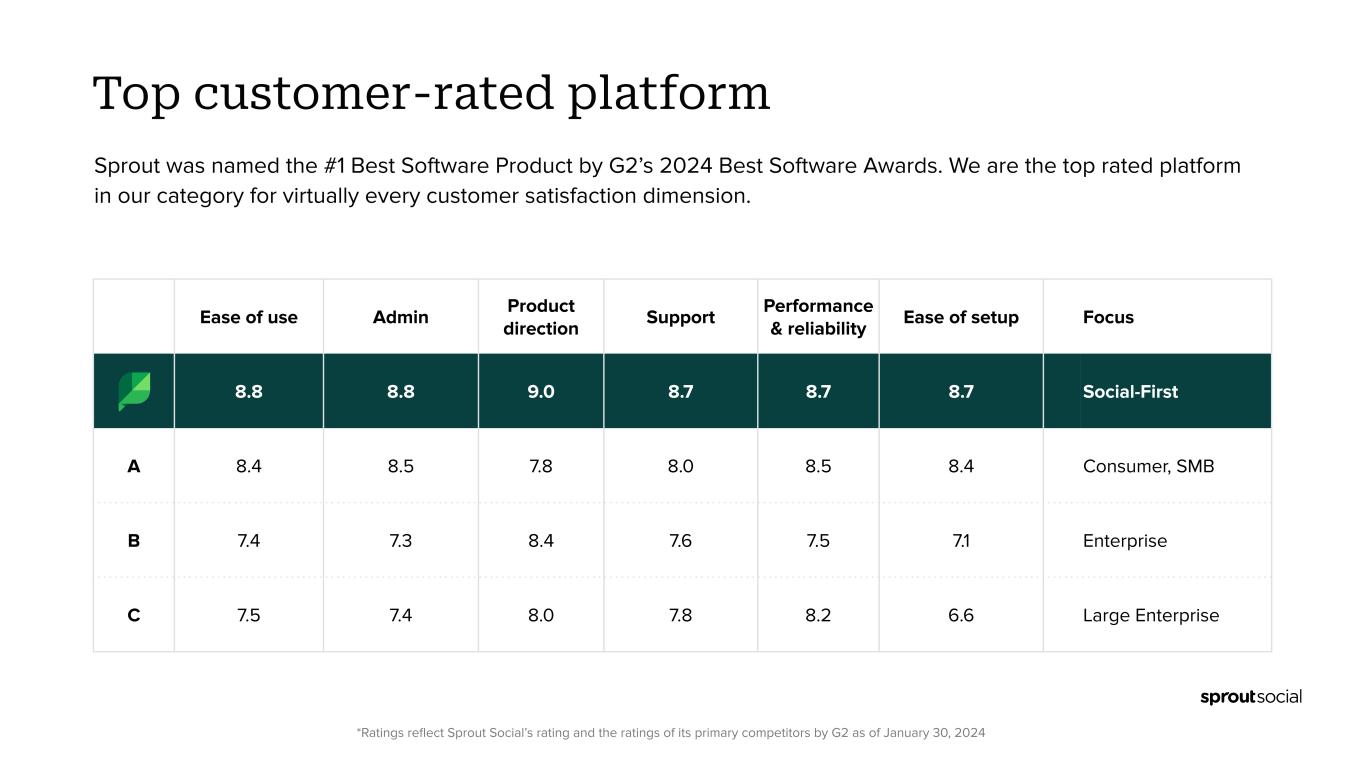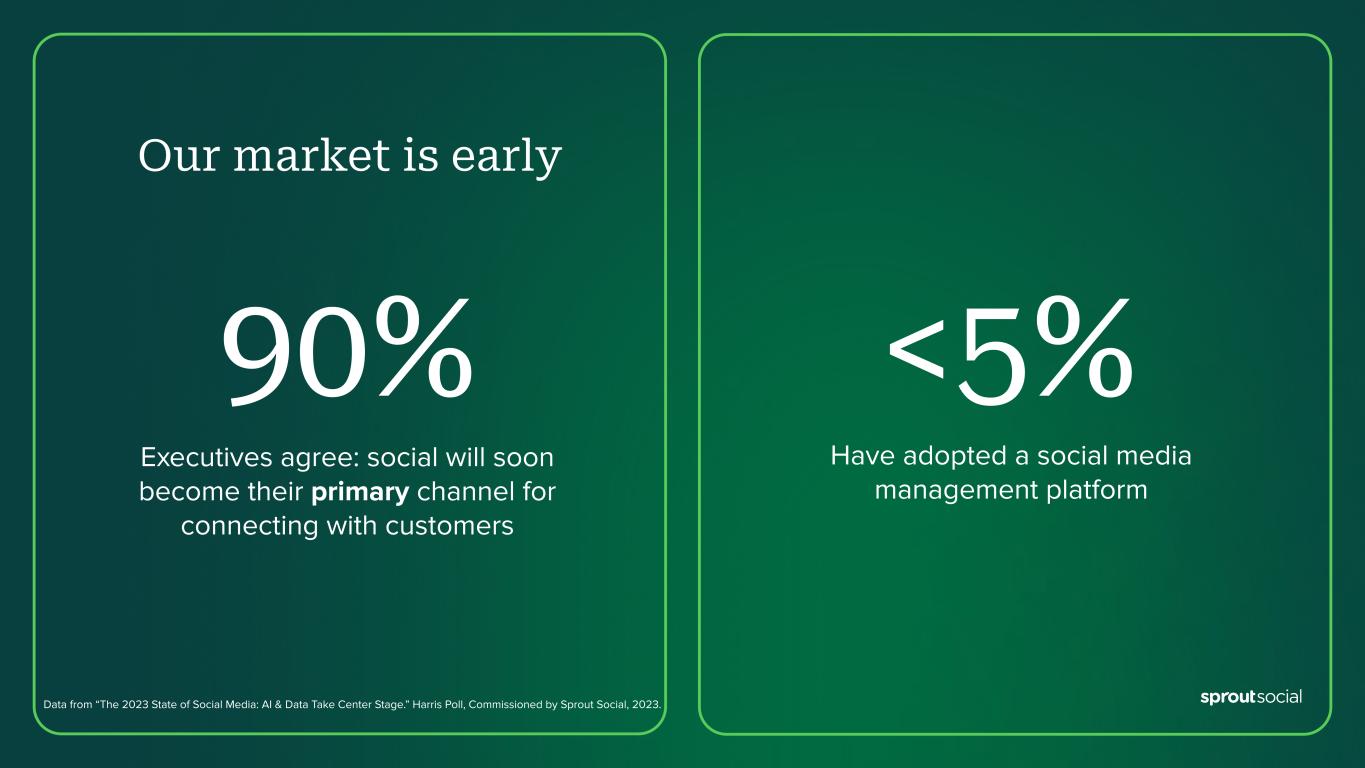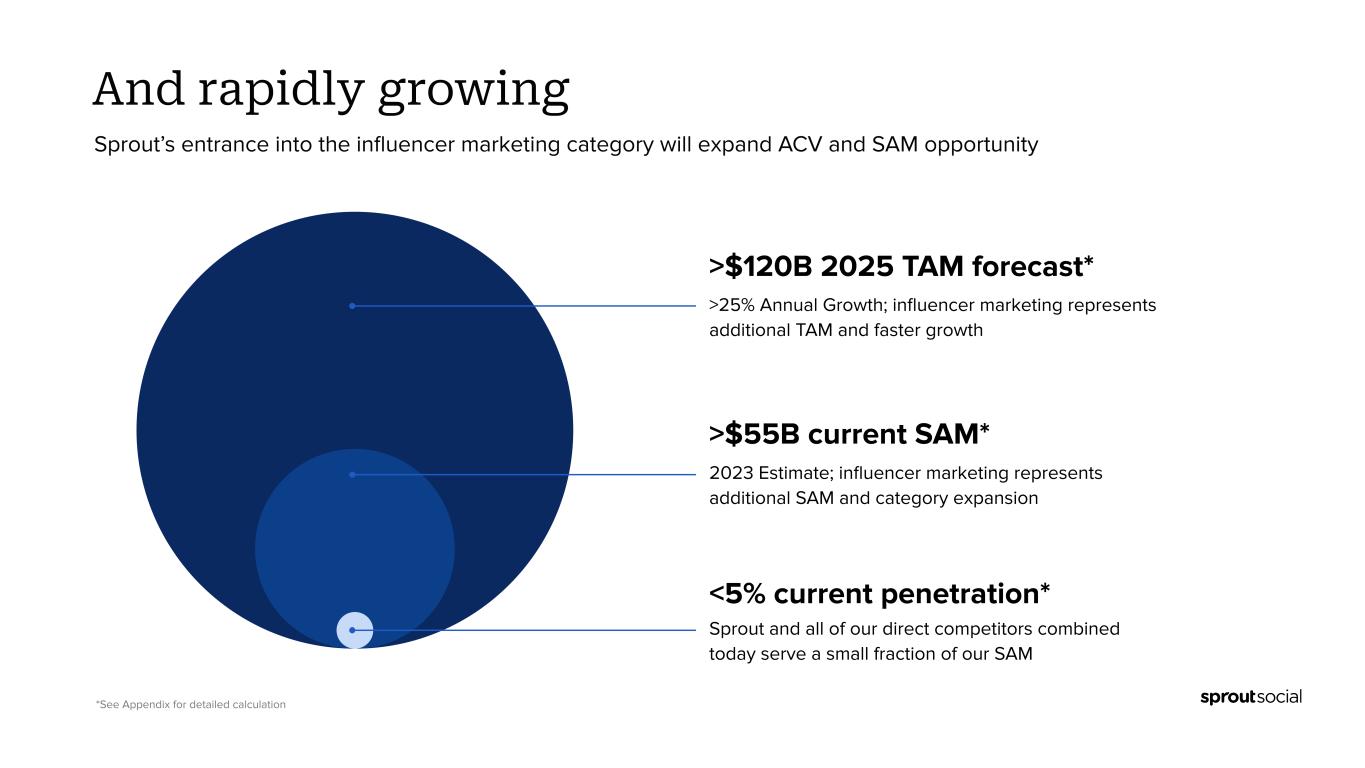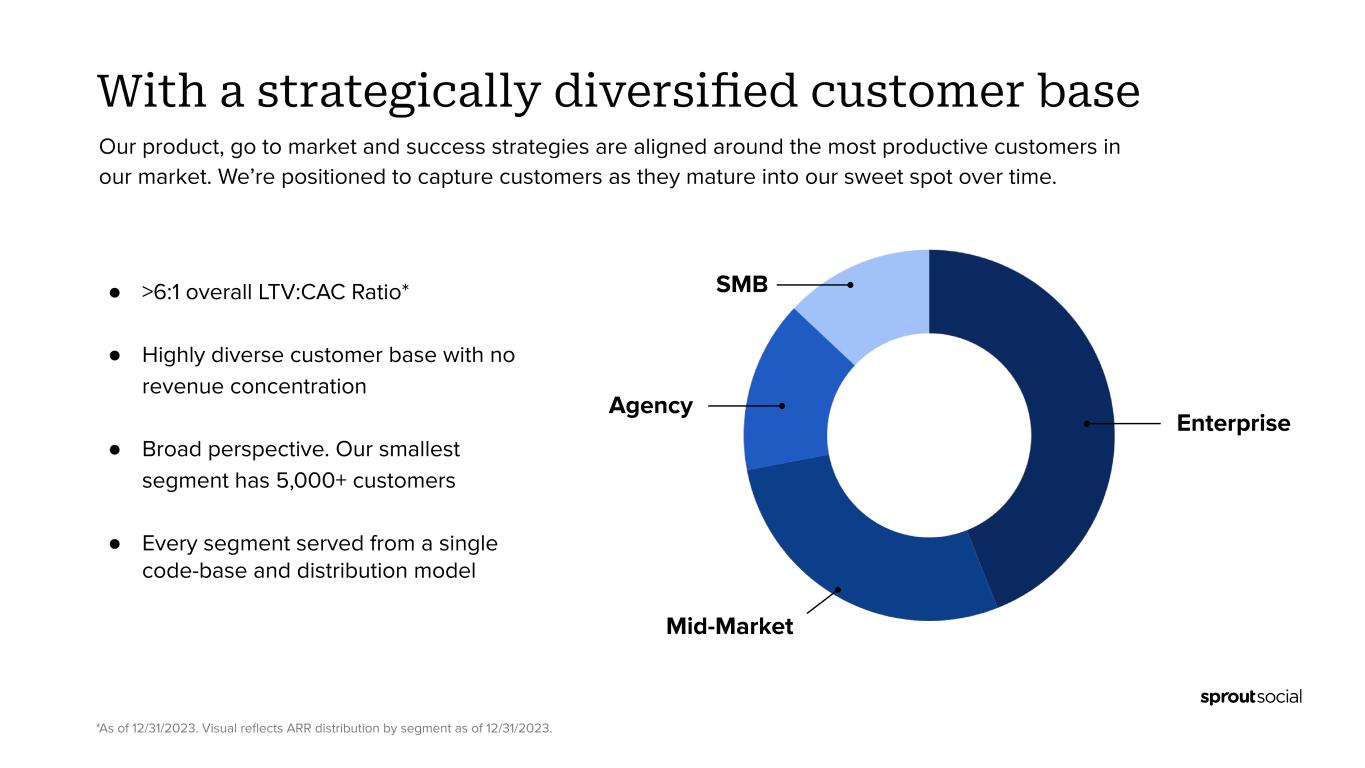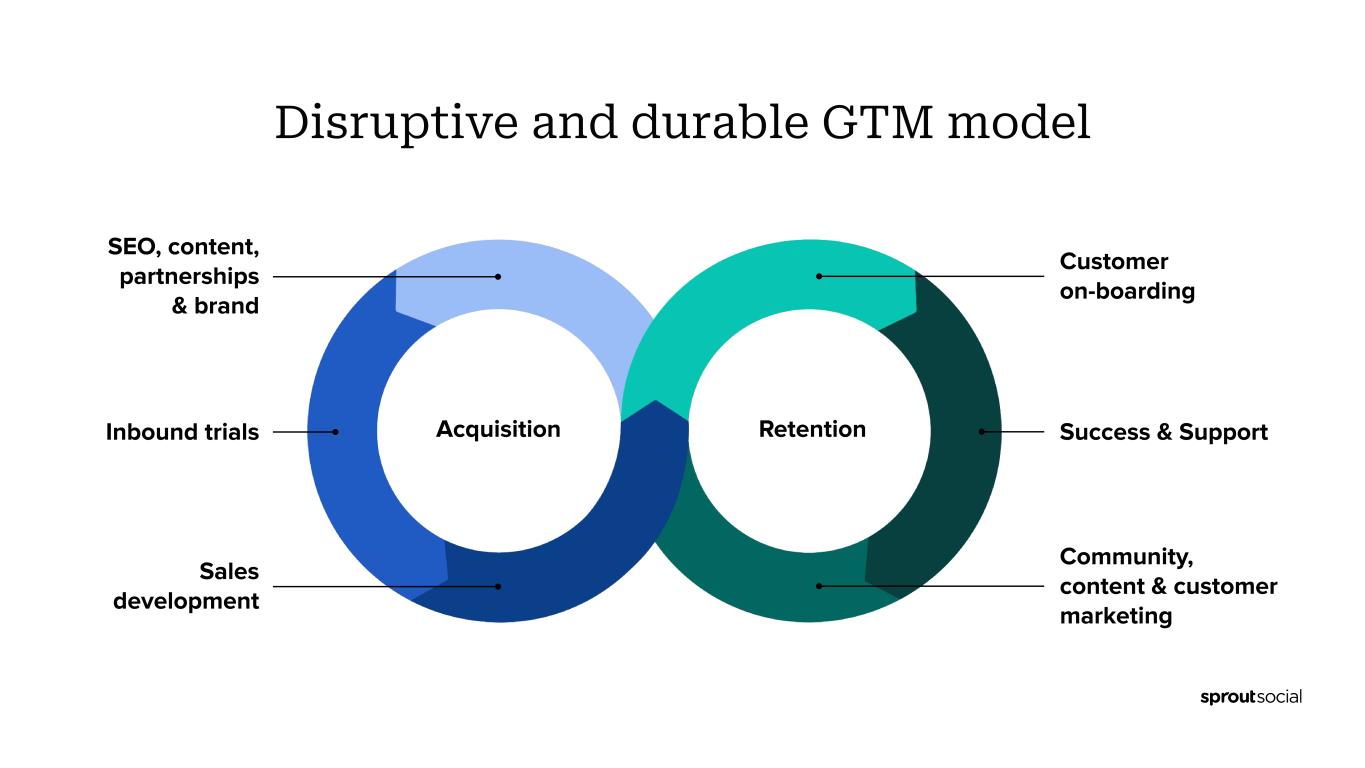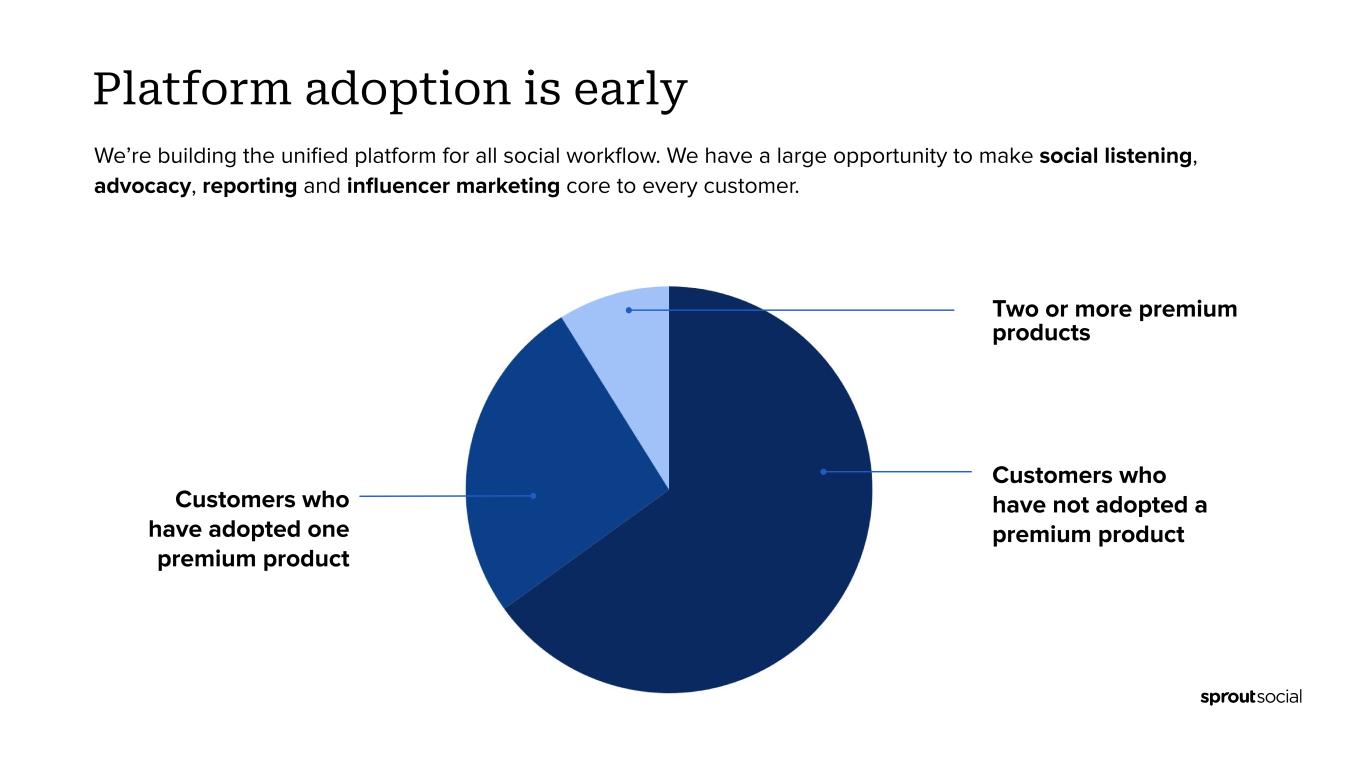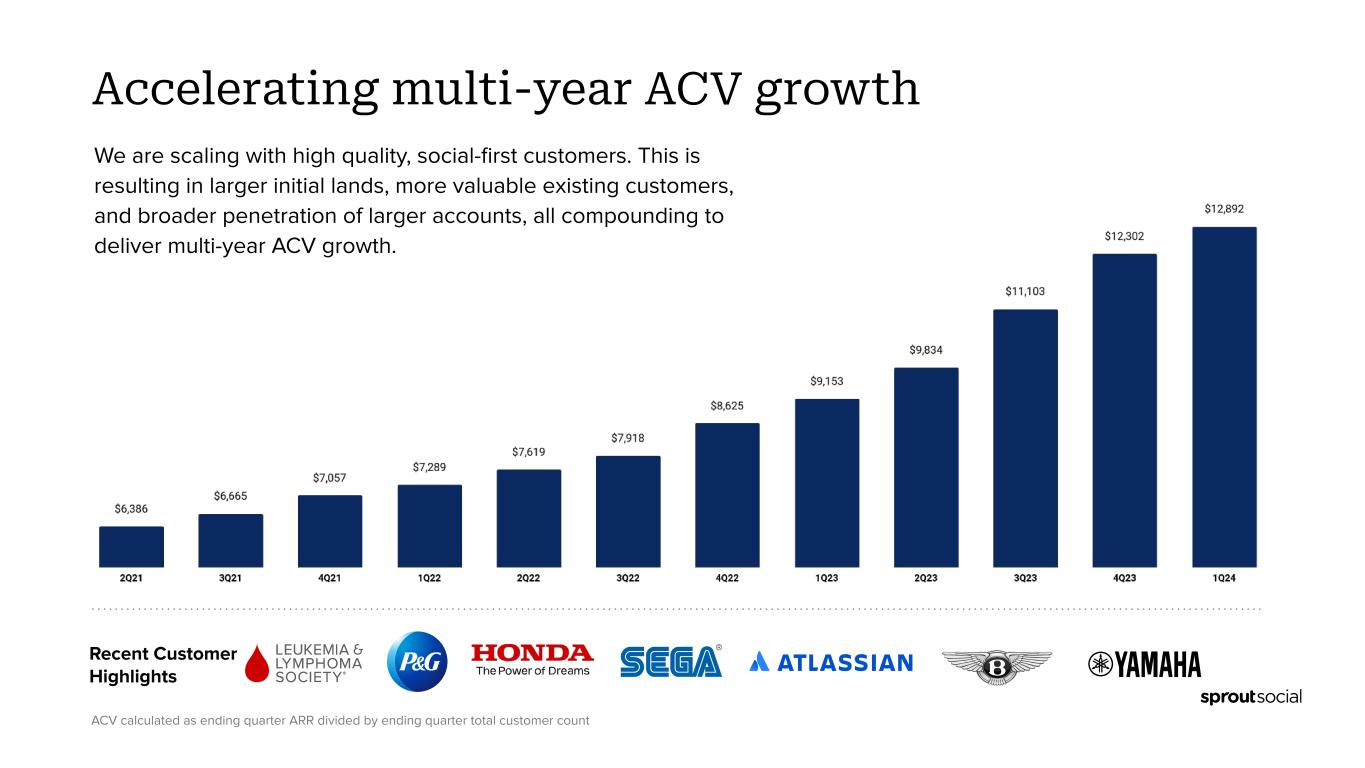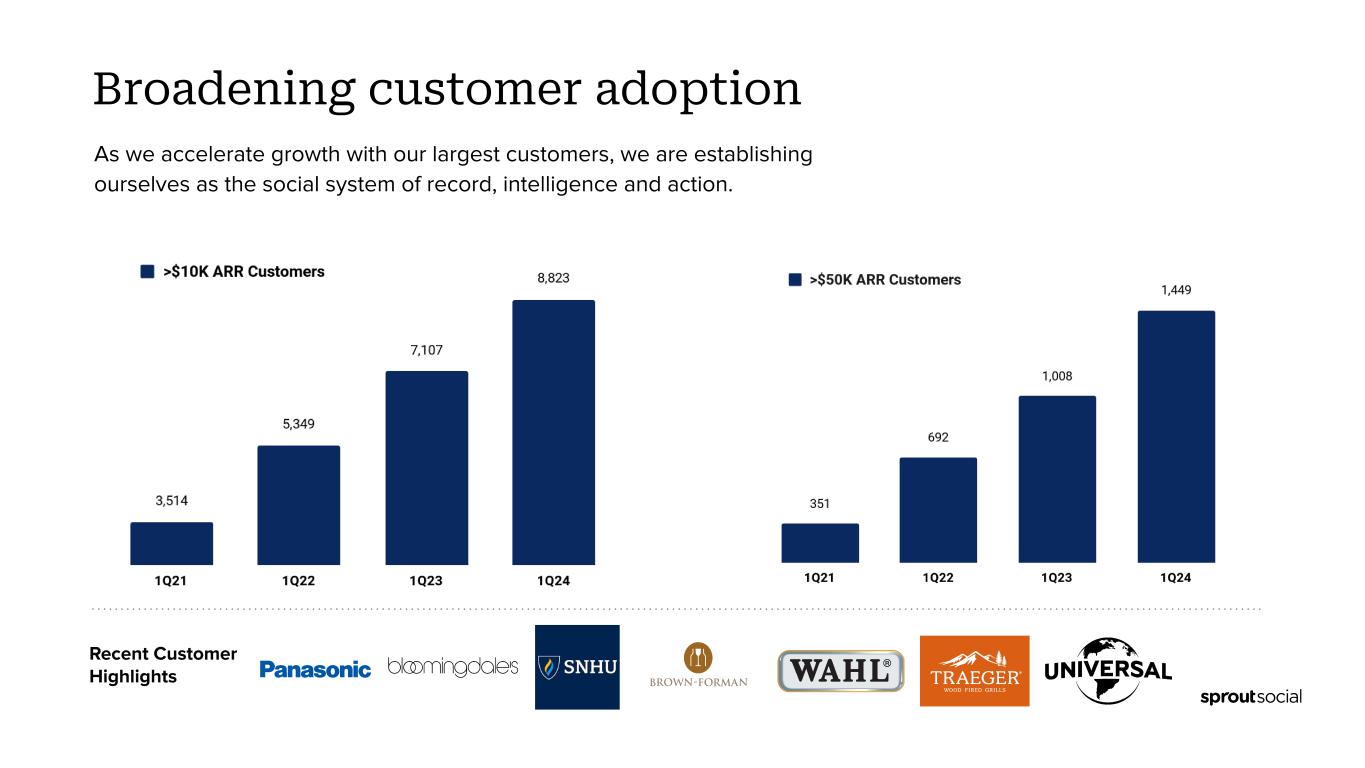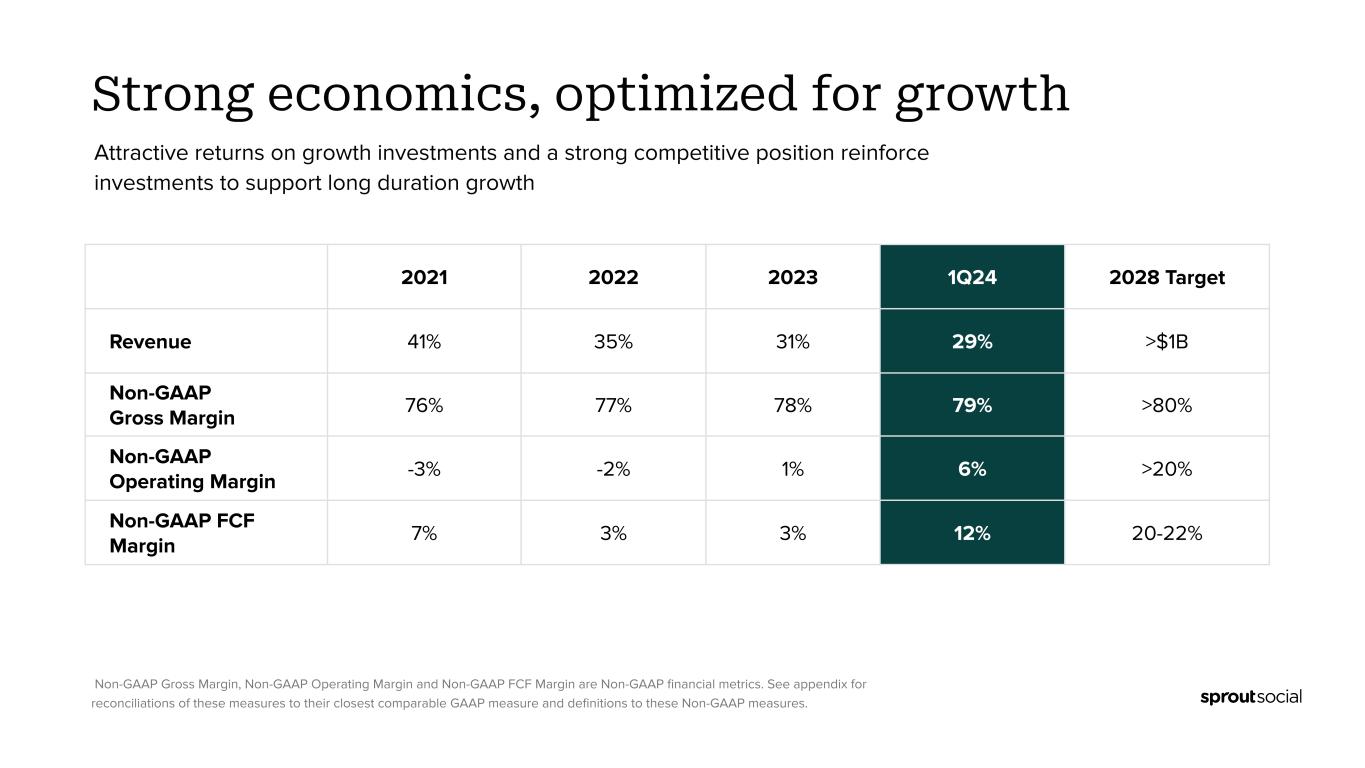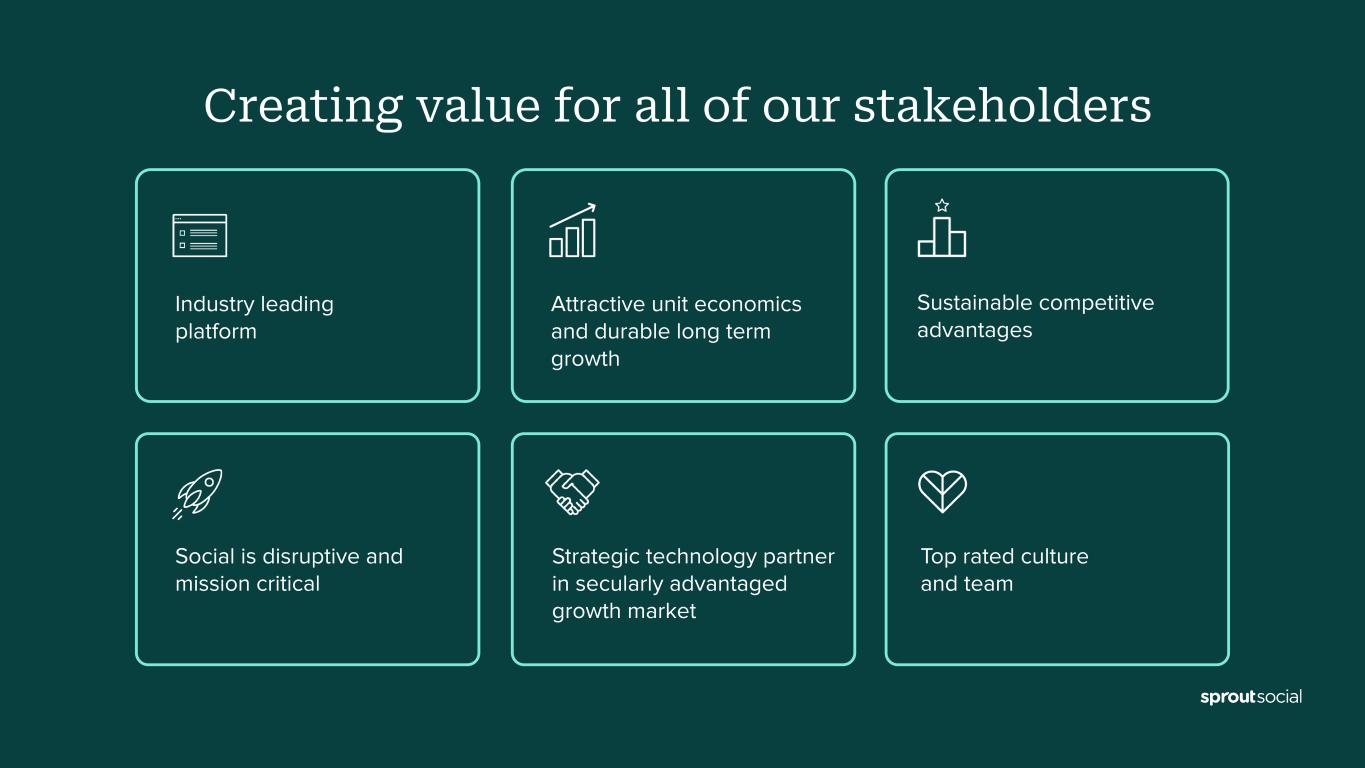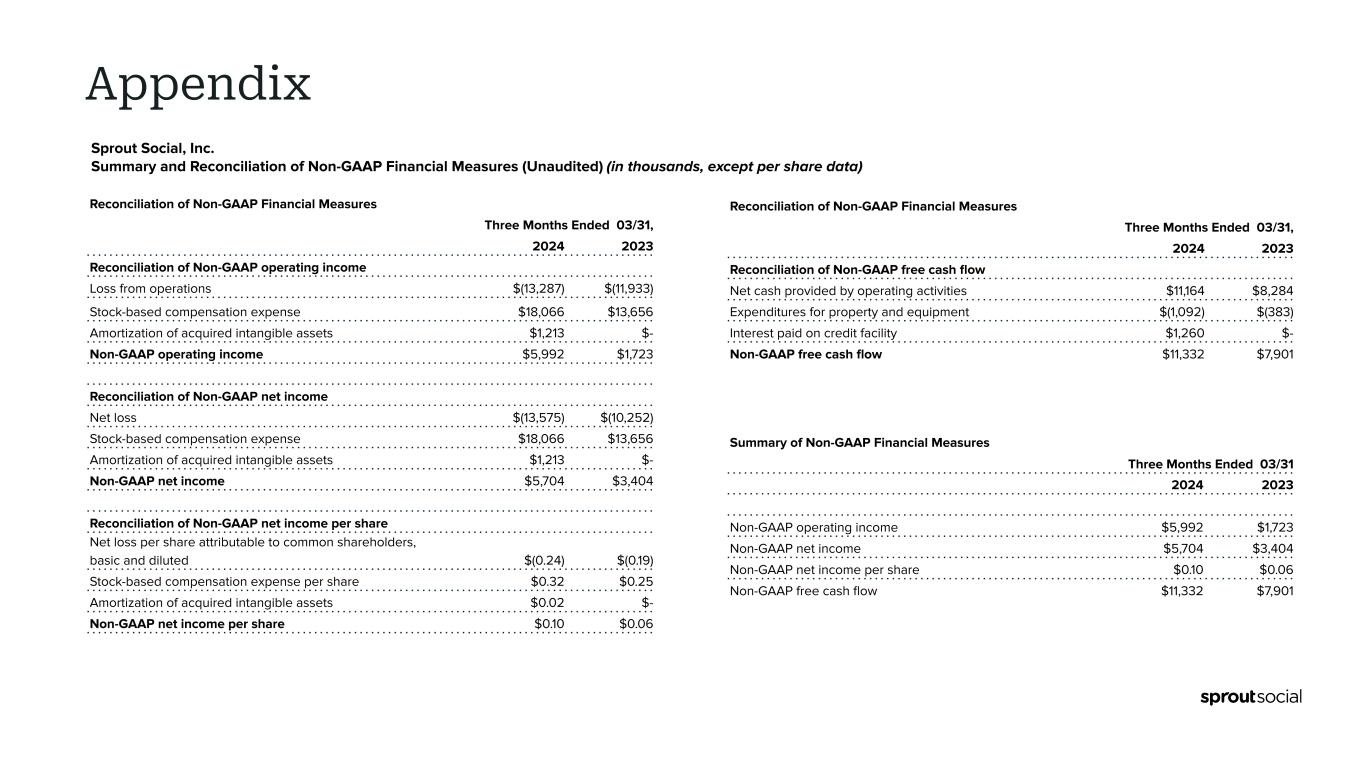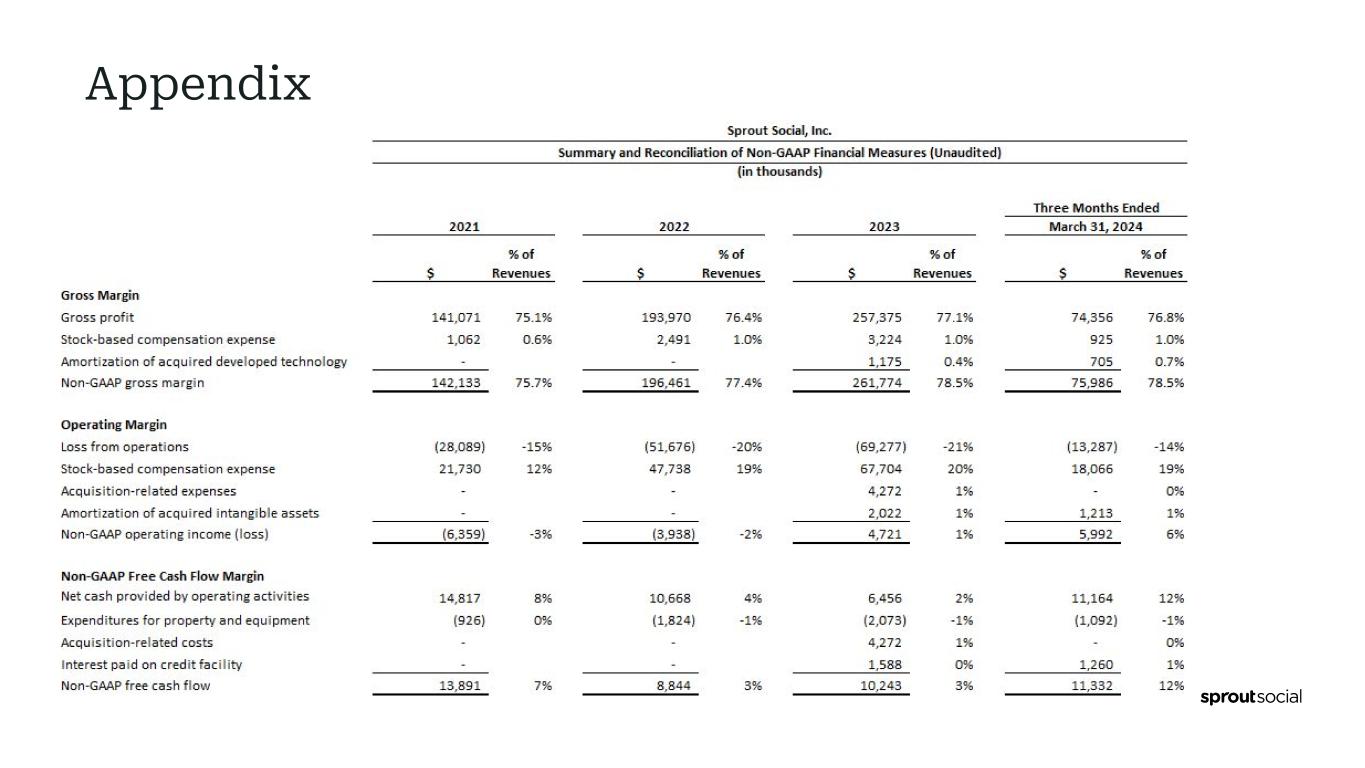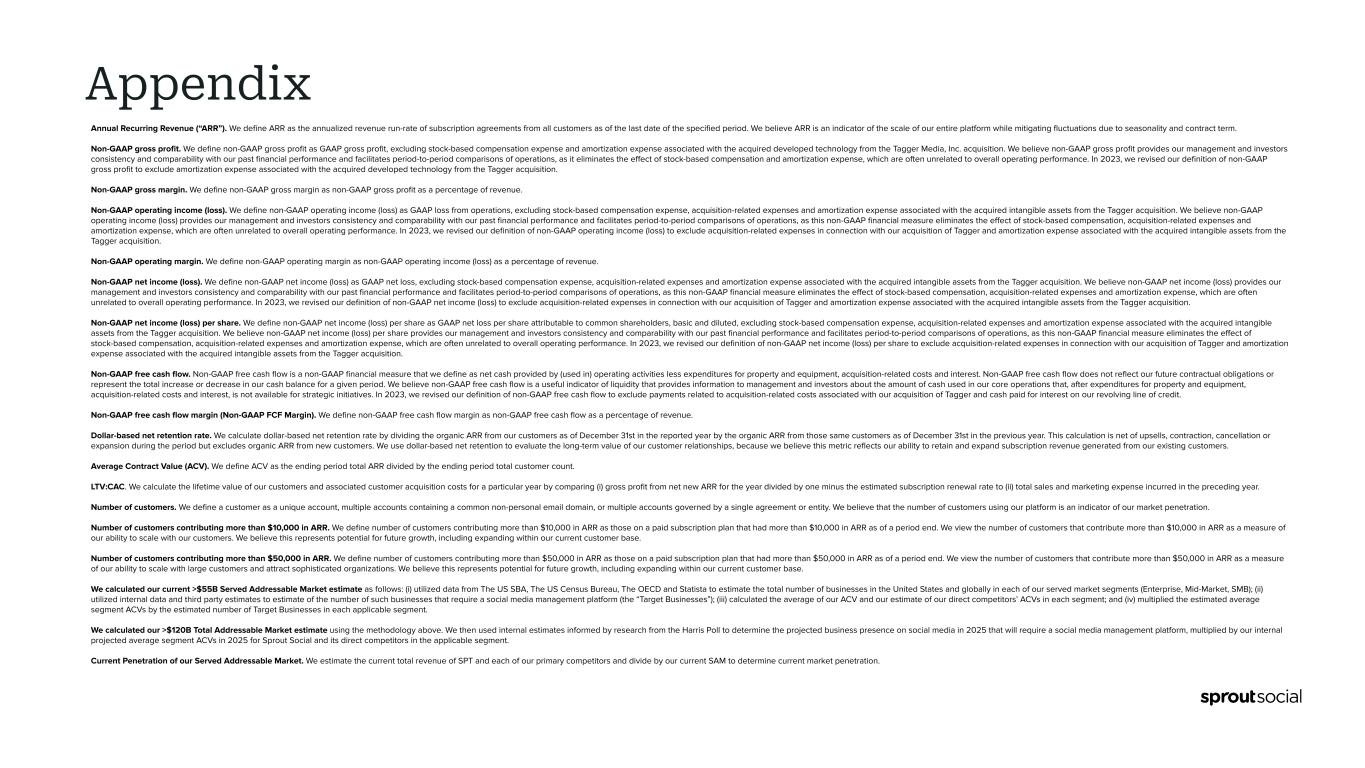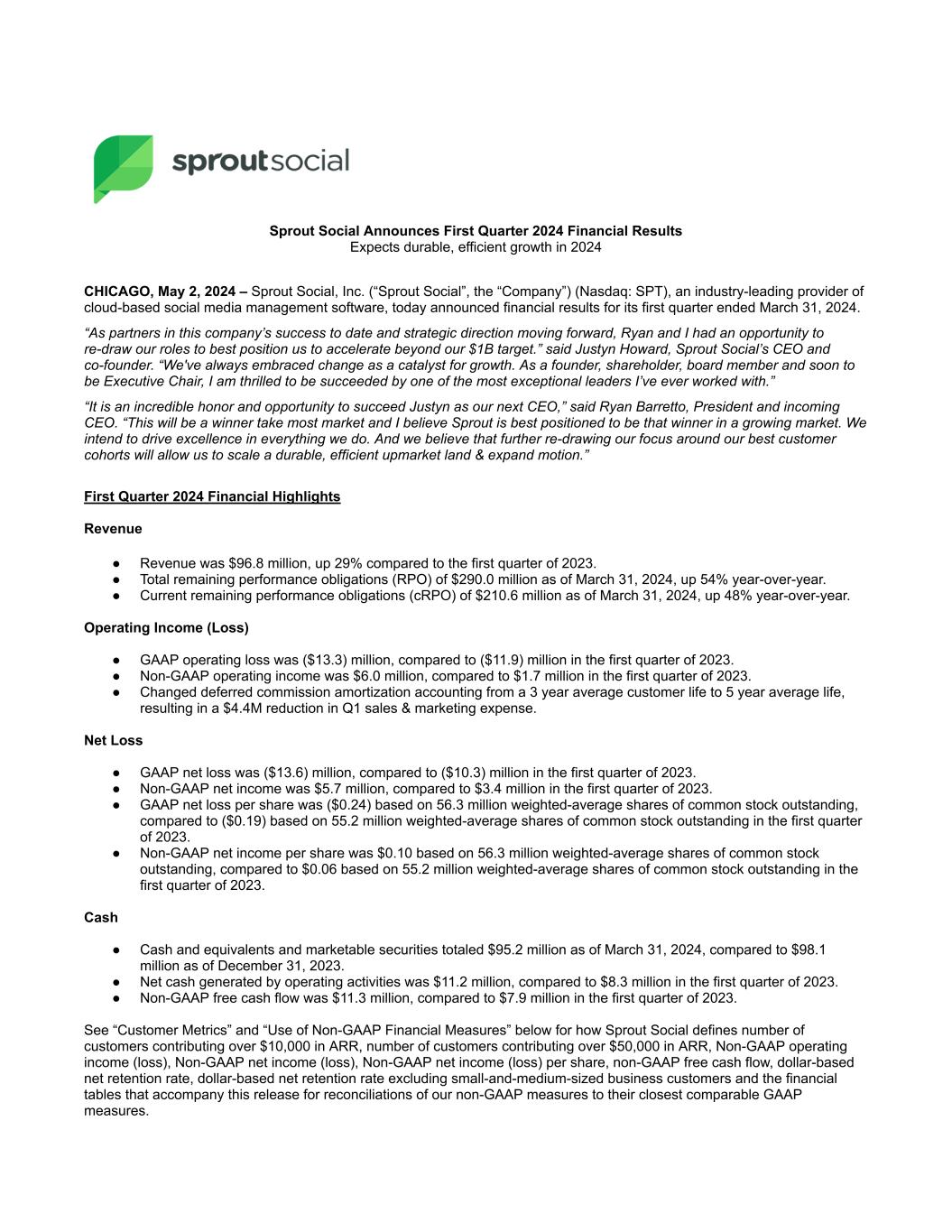
Sprout Social Announces First Quarter 2024 Financial Results Expects durable, efficient growth in 2024 CHICAGO, May 2, 2024 – Sprout Social, Inc. (“Sprout Social”, the “Company”) (Nasdaq: SPT), an industry-leading provider of cloud-based social media management software, today announced financial results for its first quarter ended March 31, 2024. “As partners in this company’s success to date and strategic direction moving forward, Ryan and I had an opportunity to re-draw our roles to best position us to accelerate beyond our $1B target.” said Justyn Howard, Sprout Social’s CEO and co-founder. “We've always embraced change as a catalyst for growth. As a founder, shareholder, board member and soon to be Executive Chair, I am thrilled to be succeeded by one of the most exceptional leaders I’ve ever worked with.” “It is an incredible honor and opportunity to succeed Justyn as our next CEO,” said Ryan Barretto, President and incoming CEO. “This will be a winner take most market and I believe Sprout is best positioned to be that winner in a growing market. We intend to drive excellence in everything we do. And we believe that further re-drawing our focus around our best customer cohorts will allow us to scale a durable, efficient upmarket land & expand motion.” First Quarter 2024 Financial Highlights Revenue ● Revenue was $96.8 million, up 29% compared to the first quarter of 2023. ● Total remaining performance obligations (RPO) of $290.0 million as of March 31, 2024, up 54% year-over-year. ● Current remaining performance obligations (cRPO) of $210.6 million as of March 31, 2024, up 48% year-over-year. Operating Income (Loss) ● GAAP operating loss was ($13.3) million, compared to ($11.9) million in the first quarter of 2023. ● Non-GAAP operating income was $6.0 million, compared to $1.7 million in the first quarter of 2023. ● Changed deferred commission amortization accounting from a 3 year average customer life to 5 year average life, resulting in a $4.4M reduction in Q1 sales & marketing expense. Net Loss ● GAAP net loss was ($13.6) million, compared to ($10.3) million in the first quarter of 2023. ● Non-GAAP net income was $5.7 million, compared to $3.4 million in the first quarter of 2023. ● GAAP net loss per share was ($0.24) based on 56.3 million weighted-average shares of common stock outstanding, compared to ($0.19) based on 55.2 million weighted-average shares of common stock outstanding in the first quarter of 2023. ● Non-GAAP net income per share was $0.10 based on 56.3 million weighted-average shares of common stock outstanding, compared to $0.06 based on 55.2 million weighted-average shares of common stock outstanding in the first quarter of 2023. Cash ● Cash and equivalents and marketable securities totaled $95.2 million as of March 31, 2024, compared to $98.1 million as of December 31, 2023. ● Net cash generated by operating activities was $11.2 million, compared to $8.3 million in the first quarter of 2023. ● Non-GAAP free cash flow was $11.3 million, compared to $7.9 million in the first quarter of 2023. See “Customer Metrics” and “Use of Non-GAAP Financial Measures” below for how Sprout Social defines number of customers contributing over $10,000 in ARR, number of customers contributing over $50,000 in ARR, Non-GAAP operating income (loss), Non-GAAP net income (loss), Non-GAAP net income (loss) per share, non-GAAP free cash flow, dollar-based net retention rate, dollar-based net retention rate excluding small-and-medium-sized business customers and the financial tables that accompany this release for reconciliations of our non-GAAP measures to their closest comparable GAAP measures.
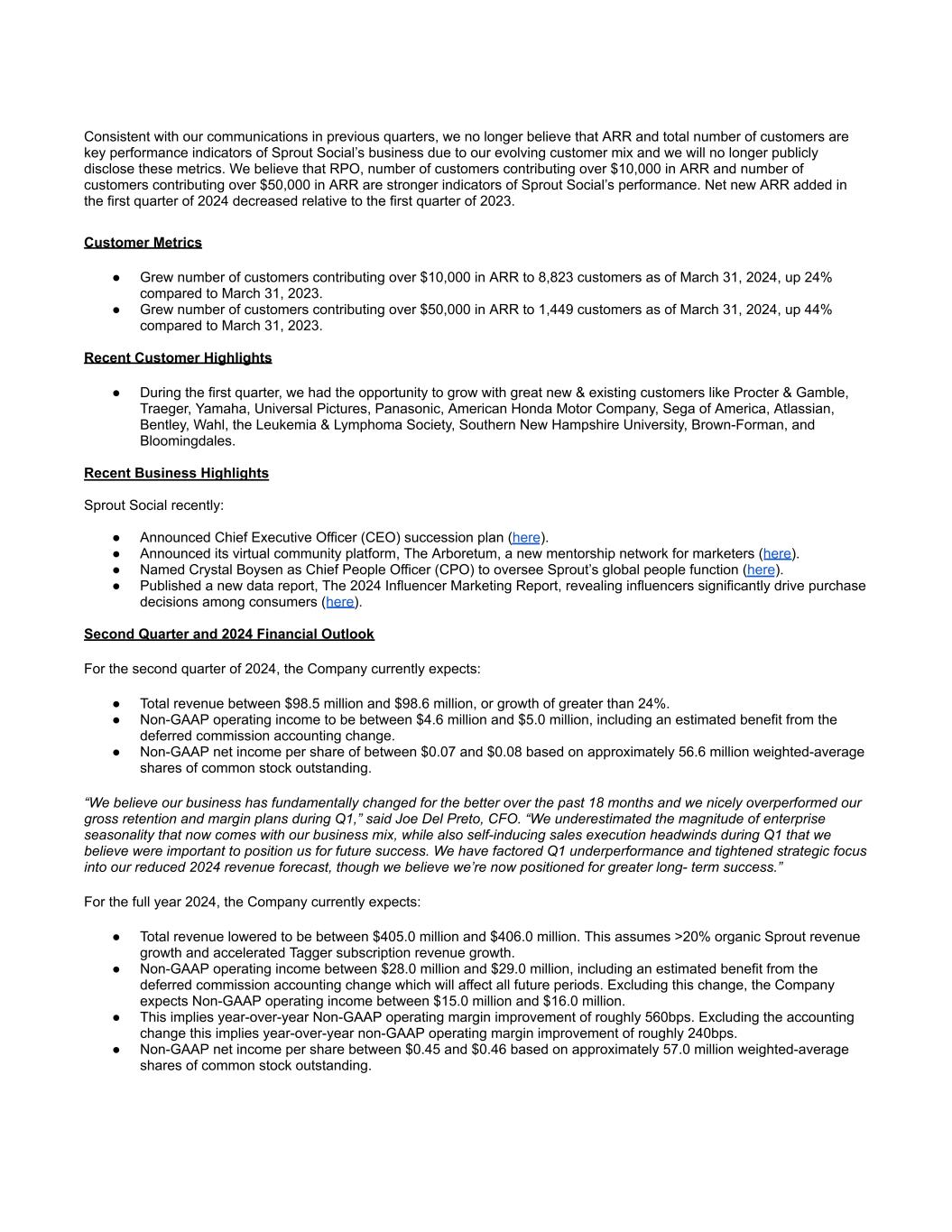
Consistent with our communications in previous quarters, we no longer believe that ARR and total number of customers are key performance indicators of Sprout Social’s business due to our evolving customer mix and we will no longer publicly disclose these metrics. We believe that RPO, number of customers contributing over $10,000 in ARR and number of customers contributing over $50,000 in ARR are stronger indicators of Sprout Social’s performance. Net new ARR added in the first quarter of 2024 decreased relative to the first quarter of 2023. Customer Metrics ● Grew number of customers contributing over $10,000 in ARR to 8,823 customers as of March 31, 2024, up 24% compared to March 31, 2023. ● Grew number of customers contributing over $50,000 in ARR to 1,449 customers as of March 31, 2024, up 44% compared to March 31, 2023. Recent Customer Highlights ● During the first quarter, we had the opportunity to grow with great new & existing customers like Procter & Gamble, Traeger, Yamaha, Universal Pictures, Panasonic, American Honda Motor Company, Sega of America, Atlassian, Bentley, Wahl, the Leukemia & Lymphoma Society, Southern New Hampshire University, Brown-Forman, and Bloomingdales. Recent Business Highlights Sprout Social recently: ● Announced Chief Executive Officer (CEO) succession plan (here). ● Announced its virtual community platform, The Arboretum, a new mentorship network for marketers (here). ● Named Crystal Boysen as Chief People Officer (CPO) to oversee Sprout’s global people function (here). ● Published a new data report, The 2024 Influencer Marketing Report, revealing influencers significantly drive purchase decisions among consumers (here). Second Quarter and 2024 Financial Outlook For the second quarter of 2024, the Company currently expects: ● Total revenue between $98.5 million and $98.6 million, or growth of greater than 24%. ● Non-GAAP operating income to be between $4.6 million and $5.0 million, including an estimated benefit from the deferred commission accounting change. ● Non-GAAP net income per share of between $0.07 and $0.08 based on approximately 56.6 million weighted-average shares of common stock outstanding. “We believe our business has fundamentally changed for the better over the past 18 months and we nicely overperformed our gross retention and margin plans during Q1,” said Joe Del Preto, CFO. “We underestimated the magnitude of enterprise seasonality that now comes with our business mix, while also self-inducing sales execution headwinds during Q1 that we believe were important to position us for future success. We have factored Q1 underperformance and tightened strategic focus into our reduced 2024 revenue forecast, though we believe we’re now positioned for greater long- term success.” For the full year 2024, the Company currently expects: ● Total revenue lowered to be between $405.0 million and $406.0 million. This assumes >20% organic Sprout revenue growth and accelerated Tagger subscription revenue growth. ● Non-GAAP operating income between $28.0 million and $29.0 million, including an estimated benefit from the deferred commission accounting change which will affect all future periods. Excluding this change, the Company expects Non-GAAP operating income between $15.0 million and $16.0 million. ● This implies year-over-year Non-GAAP operating margin improvement of roughly 560bps. Excluding the accounting change this implies year-over-year non-GAAP operating margin improvement of roughly 240bps. ● Non-GAAP net income per share between $0.45 and $0.46 based on approximately 57.0 million weighted-average shares of common stock outstanding.
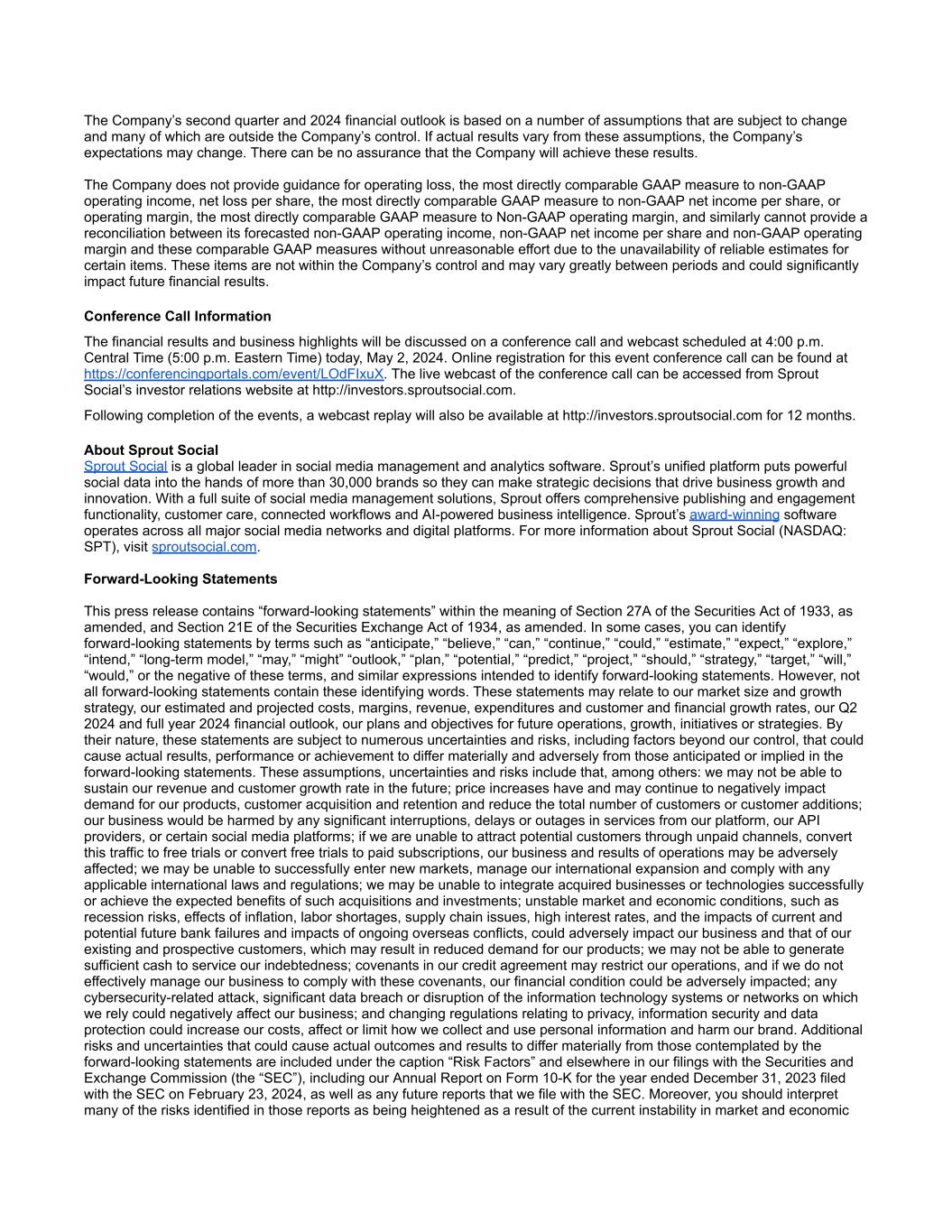
The Company’s second quarter and 2024 financial outlook is based on a number of assumptions that are subject to change and many of which are outside the Company’s control. If actual results vary from these assumptions, the Company’s expectations may change. There can be no assurance that the Company will achieve these results. The Company does not provide guidance for operating loss, the most directly comparable GAAP measure to non-GAAP operating income, net loss per share, the most directly comparable GAAP measure to non-GAAP net income per share, or operating margin, the most directly comparable GAAP measure to Non-GAAP operating margin, and similarly cannot provide a reconciliation between its forecasted non-GAAP operating income, non-GAAP net income per share and non-GAAP operating margin and these comparable GAAP measures without unreasonable effort due to the unavailability of reliable estimates for certain items. These items are not within the Company’s control and may vary greatly between periods and could significantly impact future financial results. Conference Call Information The financial results and business highlights will be discussed on a conference call and webcast scheduled at 4:00 p.m. Central Time (5:00 p.m. Eastern Time) today, May 2, 2024. Online registration for this event conference call can be found at https://conferencingportals.com/event/LOdFIxuX. The live webcast of the conference call can be accessed from Sprout Social’s investor relations website at http://investors.sproutsocial.com. Following completion of the events, a webcast replay will also be available at http://investors.sproutsocial.com for 12 months. About Sprout Social Sprout Social is a global leader in social media management and analytics software. Sprout’s unified platform puts powerful social data into the hands of more than 30,000 brands so they can make strategic decisions that drive business growth and innovation. With a full suite of social media management solutions, Sprout offers comprehensive publishing and engagement functionality, customer care, connected workflows and AI-powered business intelligence. Sprout’s award-winning software operates across all major social media networks and digital platforms. For more information about Sprout Social (NASDAQ: SPT), visit sproutsocial.com. Forward-Looking Statements This press release contains “forward-looking statements” within the meaning of Section 27A of the Securities Act of 1933, as amended, and Section 21E of the Securities Exchange Act of 1934, as amended. In some cases, you can identify forward-looking statements by terms such as “anticipate,” “believe,” “can,” “continue,” “could,” “estimate,” “expect,” “explore,” “intend,” “long-term model,” “may,” “might” “outlook,” “plan,” “potential,” “predict,” “project,” “should,” “strategy,” “target,” “will,” “would,” or the negative of these terms, and similar expressions intended to identify forward-looking statements. However, not all forward-looking statements contain these identifying words. These statements may relate to our market size and growth strategy, our estimated and projected costs, margins, revenue, expenditures and customer and financial growth rates, our Q2 2024 and full year 2024 financial outlook, our plans and objectives for future operations, growth, initiatives or strategies. By their nature, these statements are subject to numerous uncertainties and risks, including factors beyond our control, that could cause actual results, performance or achievement to differ materially and adversely from those anticipated or implied in the forward-looking statements. These assumptions, uncertainties and risks include that, among others: we may not be able to sustain our revenue and customer growth rate in the future; price increases have and may continue to negatively impact demand for our products, customer acquisition and retention and reduce the total number of customers or customer additions; our business would be harmed by any significant interruptions, delays or outages in services from our platform, our API providers, or certain social media platforms; if we are unable to attract potential customers through unpaid channels, convert this traffic to free trials or convert free trials to paid subscriptions, our business and results of operations may be adversely affected; we may be unable to successfully enter new markets, manage our international expansion and comply with any applicable international laws and regulations; we may be unable to integrate acquired businesses or technologies successfully or achieve the expected benefits of such acquisitions and investments; unstable market and economic conditions, such as recession risks, effects of inflation, labor shortages, supply chain issues, high interest rates, and the impacts of current and potential future bank failures and impacts of ongoing overseas conflicts, could adversely impact our business and that of our existing and prospective customers, which may result in reduced demand for our products; we may not be able to generate sufficient cash to service our indebtedness; covenants in our credit agreement may restrict our operations, and if we do not effectively manage our business to comply with these covenants, our financial condition could be adversely impacted; any cybersecurity-related attack, significant data breach or disruption of the information technology systems or networks on which we rely could negatively affect our business; and changing regulations relating to privacy, information security and data protection could increase our costs, affect or limit how we collect and use personal information and harm our brand. Additional risks and uncertainties that could cause actual outcomes and results to differ materially from those contemplated by the forward-looking statements are included under the caption “Risk Factors” and elsewhere in our filings with the Securities and Exchange Commission (the “SEC”), including our Annual Report on Form 10-K for the year ended December 31, 2023 filed with the SEC on February 23, 2024, as well as any future reports that we file with the SEC. Moreover, you should interpret many of the risks identified in those reports as being heightened as a result of the current instability in market and economic
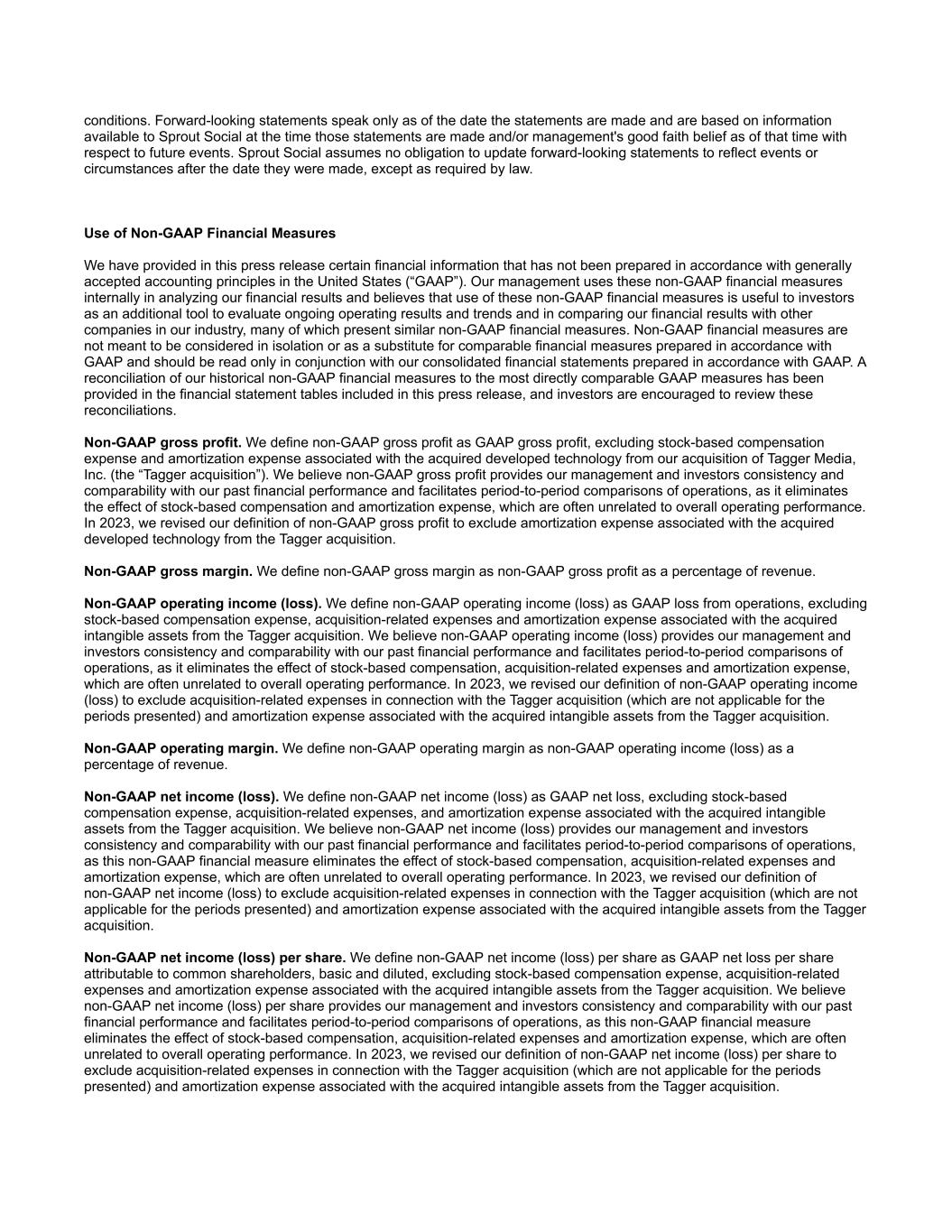
conditions. Forward-looking statements speak only as of the date the statements are made and are based on information available to Sprout Social at the time those statements are made and/or management's good faith belief as of that time with respect to future events. Sprout Social assumes no obligation to update forward-looking statements to reflect events or circumstances after the date they were made, except as required by law. Use of Non-GAAP Financial Measures We have provided in this press release certain financial information that has not been prepared in accordance with generally accepted accounting principles in the United States (“GAAP”). Our management uses these non-GAAP financial measures internally in analyzing our financial results and believes that use of these non-GAAP financial measures is useful to investors as an additional tool to evaluate ongoing operating results and trends and in comparing our financial results with other companies in our industry, many of which present similar non-GAAP financial measures. Non-GAAP financial measures are not meant to be considered in isolation or as a substitute for comparable financial measures prepared in accordance with GAAP and should be read only in conjunction with our consolidated financial statements prepared in accordance with GAAP. A reconciliation of our historical non-GAAP financial measures to the most directly comparable GAAP measures has been provided in the financial statement tables included in this press release, and investors are encouraged to review these reconciliations. Non-GAAP gross profit.We define non-GAAP gross profit as GAAP gross profit, excluding stock-based compensation expense and amortization expense associated with the acquired developed technology from our acquisition of Tagger Media, Inc. (the “Tagger acquisition”). We believe non-GAAP gross profit provides our management and investors consistency and comparability with our past financial performance and facilitates period-to-period comparisons of operations, as it eliminates the effect of stock-based compensation and amortization expense, which are often unrelated to overall operating performance. In 2023, we revised our definition of non-GAAP gross profit to exclude amortization expense associated with the acquired developed technology from the Tagger acquisition. Non-GAAP gross margin.We define non-GAAP gross margin as non-GAAP gross profit as a percentage of revenue. Non-GAAP operating income (loss).We define non-GAAP operating income (loss) as GAAP loss from operations, excluding stock-based compensation expense, acquisition-related expenses and amortization expense associated with the acquired intangible assets from the Tagger acquisition. We believe non-GAAP operating income (loss) provides our management and investors consistency and comparability with our past financial performance and facilitates period-to-period comparisons of operations, as it eliminates the effect of stock-based compensation, acquisition-related expenses and amortization expense, which are often unrelated to overall operating performance. In 2023, we revised our definition of non-GAAP operating income (loss) to exclude acquisition-related expenses in connection with the Tagger acquisition (which are not applicable for the periods presented) and amortization expense associated with the acquired intangible assets from the Tagger acquisition. Non-GAAP operating margin.We define non-GAAP operating margin as non-GAAP operating income (loss) as a percentage of revenue. Non-GAAP net income (loss).We define non-GAAP net income (loss) as GAAP net loss, excluding stock-based compensation expense, acquisition-related expenses, and amortization expense associated with the acquired intangible assets from the Tagger acquisition. We believe non-GAAP net income (loss) provides our management and investors consistency and comparability with our past financial performance and facilitates period-to-period comparisons of operations, as this non-GAAP financial measure eliminates the effect of stock-based compensation, acquisition-related expenses and amortization expense, which are often unrelated to overall operating performance. In 2023, we revised our definition of non-GAAP net income (loss) to exclude acquisition-related expenses in connection with the Tagger acquisition (which are not applicable for the periods presented) and amortization expense associated with the acquired intangible assets from the Tagger acquisition. Non-GAAP net income (loss) per share.We define non-GAAP net income (loss) per share as GAAP net loss per share attributable to common shareholders, basic and diluted, excluding stock-based compensation expense, acquisition-related expenses and amortization expense associated with the acquired intangible assets from the Tagger acquisition. We believe non-GAAP net income (loss) per share provides our management and investors consistency and comparability with our past financial performance and facilitates period-to-period comparisons of operations, as this non-GAAP financial measure eliminates the effect of stock-based compensation, acquisition-related expenses and amortization expense, which are often unrelated to overall operating performance. In 2023, we revised our definition of non-GAAP net income (loss) per share to exclude acquisition-related expenses in connection with the Tagger acquisition (which are not applicable for the periods presented) and amortization expense associated with the acquired intangible assets from the Tagger acquisition.
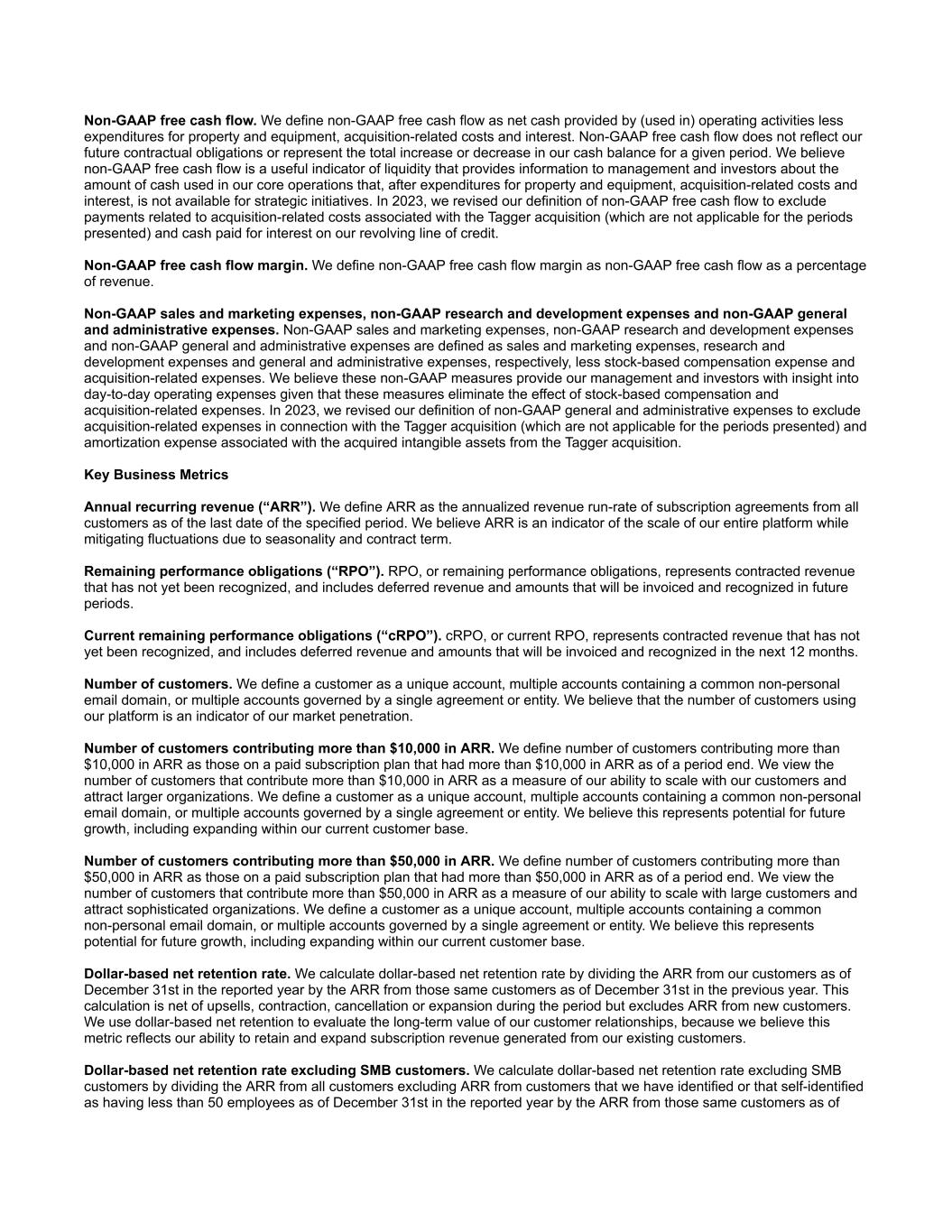
Non-GAAP free cash flow.We define non-GAAP free cash flow as net cash provided by (used in) operating activities less expenditures for property and equipment, acquisition-related costs and interest. Non-GAAP free cash flow does not reflect our future contractual obligations or represent the total increase or decrease in our cash balance for a given period. We believe non-GAAP free cash flow is a useful indicator of liquidity that provides information to management and investors about the amount of cash used in our core operations that, after expenditures for property and equipment, acquisition-related costs and interest, is not available for strategic initiatives. In 2023, we revised our definition of non-GAAP free cash flow to exclude payments related to acquisition-related costs associated with the Tagger acquisition (which are not applicable for the periods presented) and cash paid for interest on our revolving line of credit. Non-GAAP free cash flow margin.We define non-GAAP free cash flow margin as non-GAAP free cash flow as a percentage of revenue. Non-GAAP sales and marketing expenses, non-GAAP research and development expenses and non-GAAP general and administrative expenses. Non-GAAP sales and marketing expenses, non-GAAP research and development expenses and non-GAAP general and administrative expenses are defined as sales and marketing expenses, research and development expenses and general and administrative expenses, respectively, less stock-based compensation expense and acquisition-related expenses. We believe these non-GAAP measures provide our management and investors with insight into day-to-day operating expenses given that these measures eliminate the effect of stock-based compensation and acquisition-related expenses. In 2023, we revised our definition of non-GAAP general and administrative expenses to exclude acquisition-related expenses in connection with the Tagger acquisition (which are not applicable for the periods presented) and amortization expense associated with the acquired intangible assets from the Tagger acquisition. Key Business Metrics Annual recurring revenue (“ARR”).We define ARR as the annualized revenue run-rate of subscription agreements from all customers as of the last date of the specified period. We believe ARR is an indicator of the scale of our entire platform while mitigating fluctuations due to seasonality and contract term. Remaining performance obligations (“RPO”). RPO, or remaining performance obligations, represents contracted revenue that has not yet been recognized, and includes deferred revenue and amounts that will be invoiced and recognized in future periods. Current remaining performance obligations (“cRPO”). cRPO, or current RPO, represents contracted revenue that has not yet been recognized, and includes deferred revenue and amounts that will be invoiced and recognized in the next 12 months. Number of customers.We define a customer as a unique account, multiple accounts containing a common non-personal email domain, or multiple accounts governed by a single agreement or entity. We believe that the number of customers using our platform is an indicator of our market penetration. Number of customers contributing more than $10,000 in ARR.We define number of customers contributing more than $10,000 in ARR as those on a paid subscription plan that had more than $10,000 in ARR as of a period end. We view the number of customers that contribute more than $10,000 in ARR as a measure of our ability to scale with our customers and attract larger organizations. We define a customer as a unique account, multiple accounts containing a common non-personal email domain, or multiple accounts governed by a single agreement or entity. We believe this represents potential for future growth, including expanding within our current customer base. Number of customers contributing more than $50,000 in ARR.We define number of customers contributing more than $50,000 in ARR as those on a paid subscription plan that had more than $50,000 in ARR as of a period end. We view the number of customers that contribute more than $50,000 in ARR as a measure of our ability to scale with large customers and attract sophisticated organizations. We define a customer as a unique account, multiple accounts containing a common non-personal email domain, or multiple accounts governed by a single agreement or entity. We believe this represents potential for future growth, including expanding within our current customer base. Dollar-based net retention rate.We calculate dollar-based net retention rate by dividing the ARR from our customers as of December 31st in the reported year by the ARR from those same customers as of December 31st in the previous year. This calculation is net of upsells, contraction, cancellation or expansion during the period but excludes ARR from new customers. We use dollar-based net retention to evaluate the long-term value of our customer relationships, because we believe this metric reflects our ability to retain and expand subscription revenue generated from our existing customers. Dollar-based net retention rate excluding SMB customers.We calculate dollar-based net retention rate excluding SMB customers by dividing the ARR from all customers excluding ARR from customers that we have identified or that self-identified as having less than 50 employees as of December 31st in the reported year by the ARR from those same customers as of
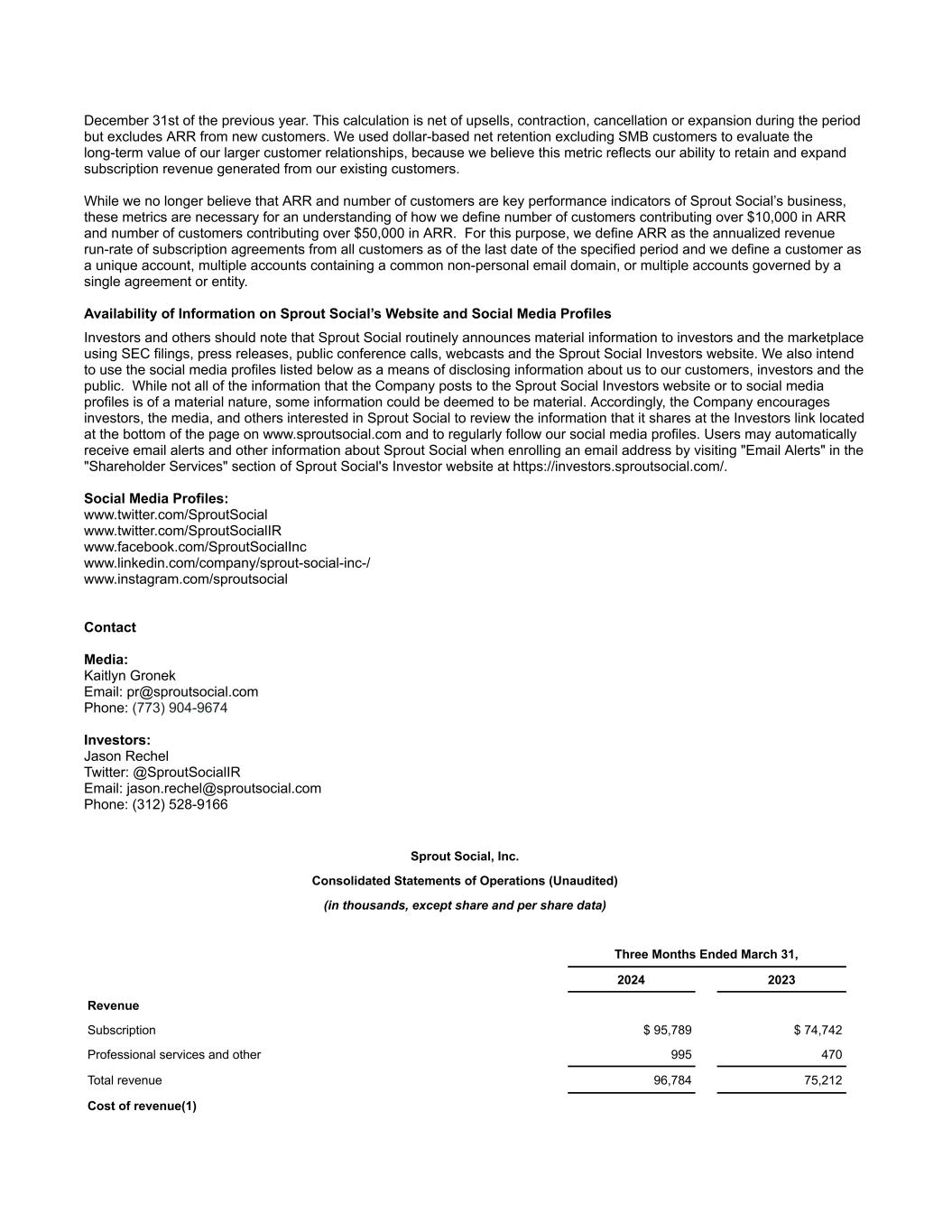
December 31st of the previous year. This calculation is net of upsells, contraction, cancellation or expansion during the period but excludes ARR from new customers. We used dollar-based net retention excluding SMB customers to evaluate the long-term value of our larger customer relationships, because we believe this metric reflects our ability to retain and expand subscription revenue generated from our existing customers. While we no longer believe that ARR and number of customers are key performance indicators of Sprout Social’s business, these metrics are necessary for an understanding of how we define number of customers contributing over $10,000 in ARR and number of customers contributing over $50,000 in ARR. For this purpose, we define ARR as the annualized revenue run-rate of subscription agreements from all customers as of the last date of the specified period and we define a customer as a unique account, multiple accounts containing a common non-personal email domain, or multiple accounts governed by a single agreement or entity. Availability of Information on Sprout Social’s Website and Social Media Profiles Investors and others should note that Sprout Social routinely announces material information to investors and the marketplace using SEC filings, press releases, public conference calls, webcasts and the Sprout Social Investors website. We also intend to use the social media profiles listed below as a means of disclosing information about us to our customers, investors and the public. While not all of the information that the Company posts to the Sprout Social Investors website or to social media profiles is of a material nature, some information could be deemed to be material. Accordingly, the Company encourages investors, the media, and others interested in Sprout Social to review the information that it shares at the Investors link located at the bottom of the page on www.sproutsocial.com and to regularly follow our social media profiles. Users may automatically receive email alerts and other information about Sprout Social when enrolling an email address by visiting "Email Alerts" in the "Shareholder Services" section of Sprout Social's Investor website at https://investors.sproutsocial.com/. Social Media Profiles: www.twitter.com/SproutSocial www.twitter.com/SproutSocialIR www.facebook.com/SproutSocialInc www.linkedin.com/company/sprout-social-inc-/ www.instagram.com/sproutsocial Contact Media: Kaitlyn Gronek Email: pr@sproutsocial.com Phone: (773) 904-9674 Investors: Jason Rechel Twitter: @SproutSocialIR Email: jason.rechel@sproutsocial.com Phone: (312) 528-9166 Sprout Social, Inc. Consolidated Statements of Operations (Unaudited) (in thousands, except share and per share data) Three Months Ended March 31, 2024 2023 Revenue Subscription $ 95,789 $ 74,742 Professional services and other 995 470 Total revenue 96,784 75,212 Cost of revenue(1)
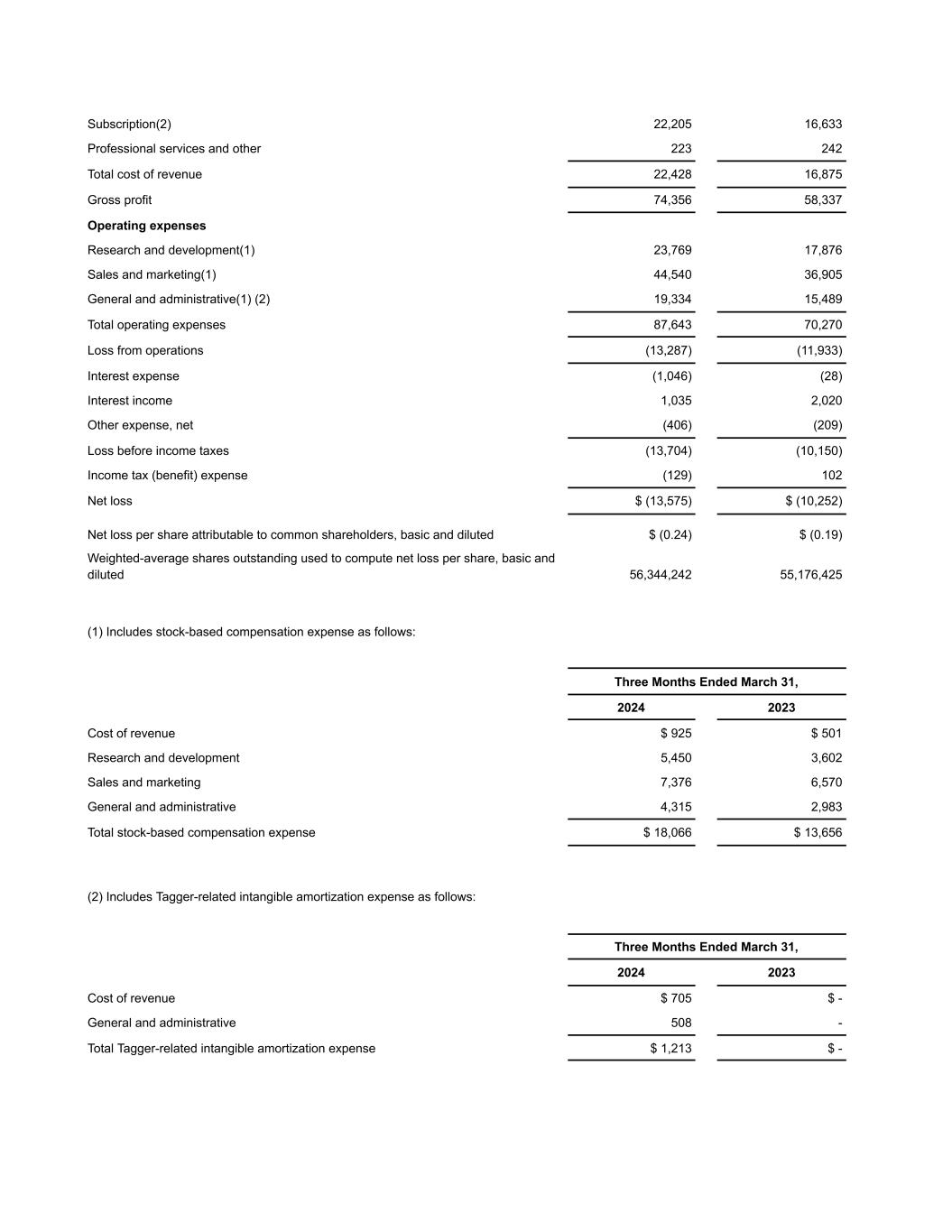
Subscription(2) 22,205 16,633 Professional services and other 223 242 Total cost of revenue 22,428 16,875 Gross profit 74,356 58,337 Operating expenses Research and development(1) 23,769 17,876 Sales and marketing(1) 44,540 36,905 General and administrative(1) (2) 19,334 15,489 Total operating expenses 87,643 70,270 Loss from operations (13,287) (11,933) Interest expense (1,046) (28) Interest income 1,035 2,020 Other expense, net (406) (209) Loss before income taxes (13,704) (10,150) Income tax (benefit) expense (129) 102 Net loss $ (13,575) $ (10,252) Net loss per share attributable to common shareholders, basic and diluted $ (0.24) $ (0.19) Weighted-average shares outstanding used to compute net loss per share, basic and diluted 56,344,242 55,176,425 (1) Includes stock-based compensation expense as follows: Three Months Ended March 31, 2024 2023 Cost of revenue $ 925 $ 501 Research and development 5,450 3,602 Sales and marketing 7,376 6,570 General and administrative 4,315 2,983 Total stock-based compensation expense $ 18,066 $ 13,656 (2) Includes Tagger-related intangible amortization expense as follows: Three Months Ended March 31, 2024 2023 Cost of revenue $ 705 $ - General and administrative 508 - Total Tagger-related intangible amortization expense $ 1,213 $ -
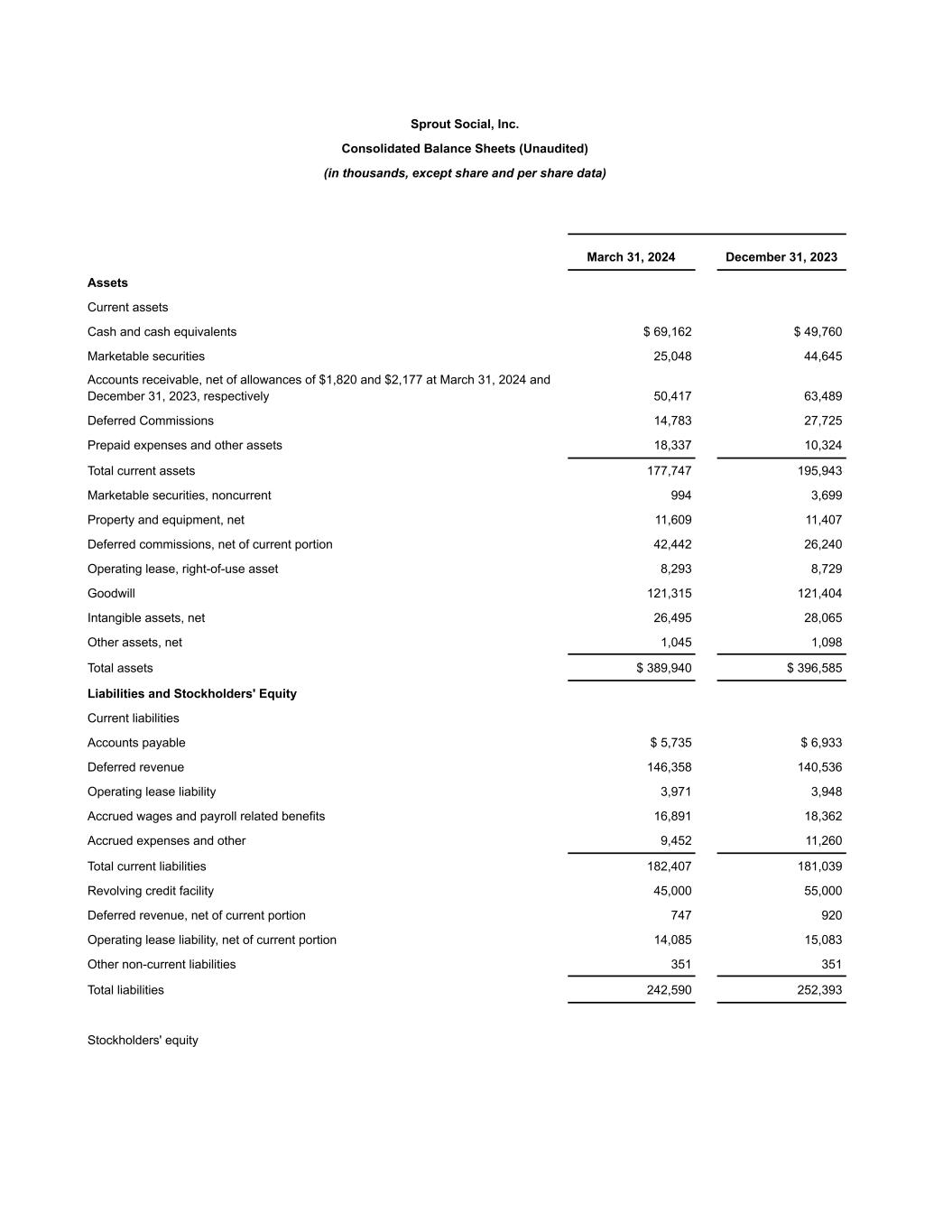
Sprout Social, Inc. Consolidated Balance Sheets (Unaudited) (in thousands, except share and per share data) March 31, 2024 December 31, 2023 Assets Current assets Cash and cash equivalents $ 69,162 $ 49,760 Marketable securities 25,048 44,645 Accounts receivable, net of allowances of $1,820 and $2,177 at March 31, 2024 and December 31, 2023, respectively 50,417 63,489 Deferred Commissions 14,783 27,725 Prepaid expenses and other assets 18,337 10,324 Total current assets 177,747 195,943 Marketable securities, noncurrent 994 3,699 Property and equipment, net 11,609 11,407 Deferred commissions, net of current portion 42,442 26,240 Operating lease, right-of-use asset 8,293 8,729 Goodwill 121,315 121,404 Intangible assets, net 26,495 28,065 Other assets, net 1,045 1,098 Total assets $ 389,940 $ 396,585 Liabilities and Stockholders' Equity Current liabilities Accounts payable $ 5,735 $ 6,933 Deferred revenue 146,358 140,536 Operating lease liability 3,971 3,948 Accrued wages and payroll related benefits 16,891 18,362 Accrued expenses and other 9,452 11,260 Total current liabilities 182,407 181,039 Revolving credit facility 45,000 55,000 Deferred revenue, net of current portion 747 920 Operating lease liability, net of current portion 14,085 15,083 Other non-current liabilities 351 351 Total liabilities 242,590 252,393 Stockholders' equity
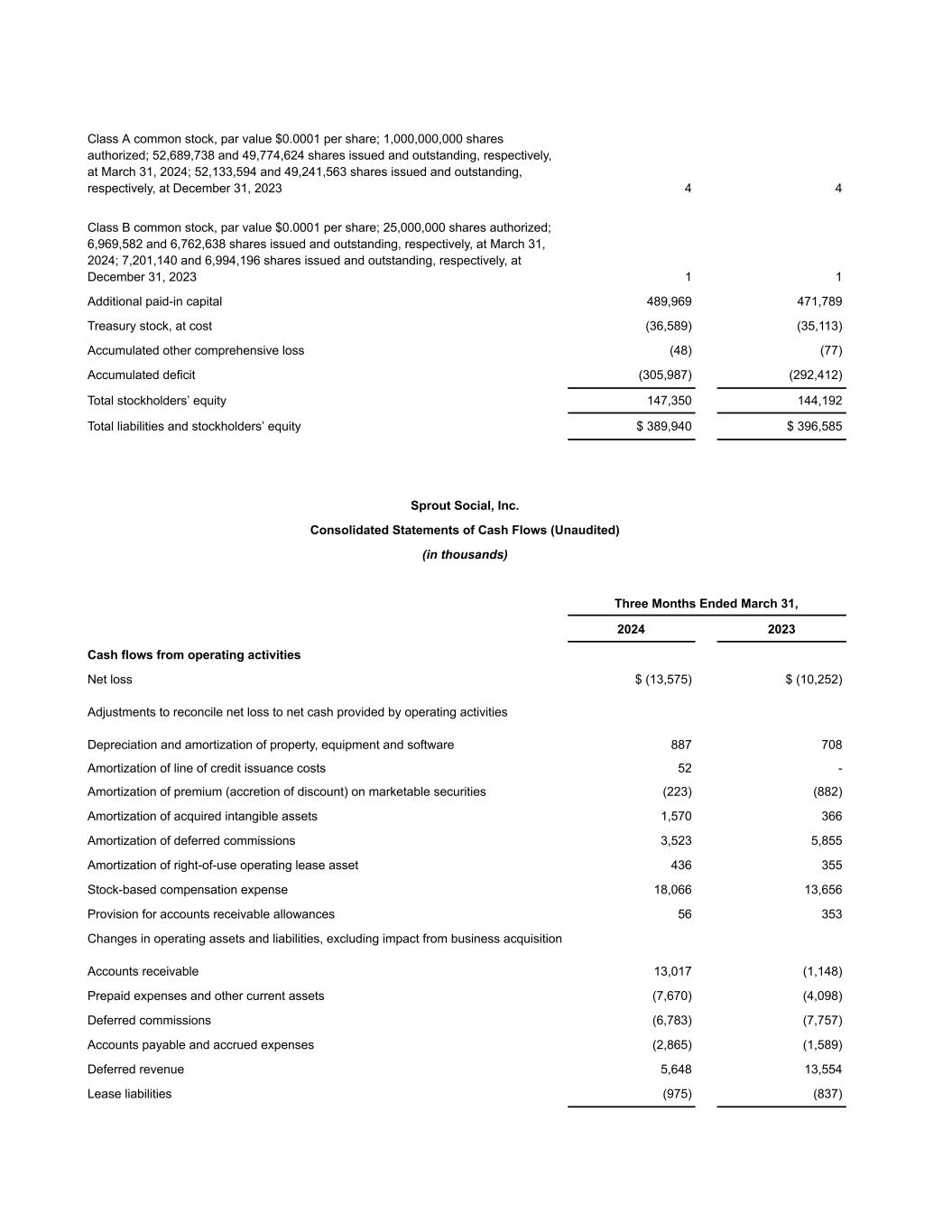
Class A common stock, par value $0.0001 per share; 1,000,000,000 shares authorized; 52,689,738 and 49,774,624 shares issued and outstanding, respectively, at March 31, 2024; 52,133,594 and 49,241,563 shares issued and outstanding, respectively, at December 31, 2023 4 4 Class B common stock, par value $0.0001 per share; 25,000,000 shares authorized; 6,969,582 and 6,762,638 shares issued and outstanding, respectively, at March 31, 2024; 7,201,140 and 6,994,196 shares issued and outstanding, respectively, at December 31, 2023 1 1 Additional paid-in capital 489,969 471,789 Treasury stock, at cost (36,589) (35,113) Accumulated other comprehensive loss (48) (77) Accumulated deficit (305,987) (292,412) Total stockholders’ equity 147,350 144,192 Total liabilities and stockholders’ equity $ 389,940 $ 396,585 Sprout Social, Inc. Consolidated Statements of Cash Flows (Unaudited) (in thousands) Three Months Ended March 31, 2024 2023 Cash flows from operating activities Net loss $ (13,575) $ (10,252) Adjustments to reconcile net loss to net cash provided by operating activities Depreciation and amortization of property, equipment and software 887 708 Amortization of line of credit issuance costs 52 - Amortization of premium (accretion of discount) on marketable securities (223) (882) Amortization of acquired intangible assets 1,570 366 Amortization of deferred commissions 3,523 5,855 Amortization of right-of-use operating lease asset 436 355 Stock-based compensation expense 18,066 13,656 Provision for accounts receivable allowances 56 353 Changes in operating assets and liabilities, excluding impact from business acquisition Accounts receivable 13,017 (1,148) Prepaid expenses and other current assets (7,670) (4,098) Deferred commissions (6,783) (7,757) Accounts payable and accrued expenses (2,865) (1,589) Deferred revenue 5,648 13,554 Lease liabilities (975) (837)
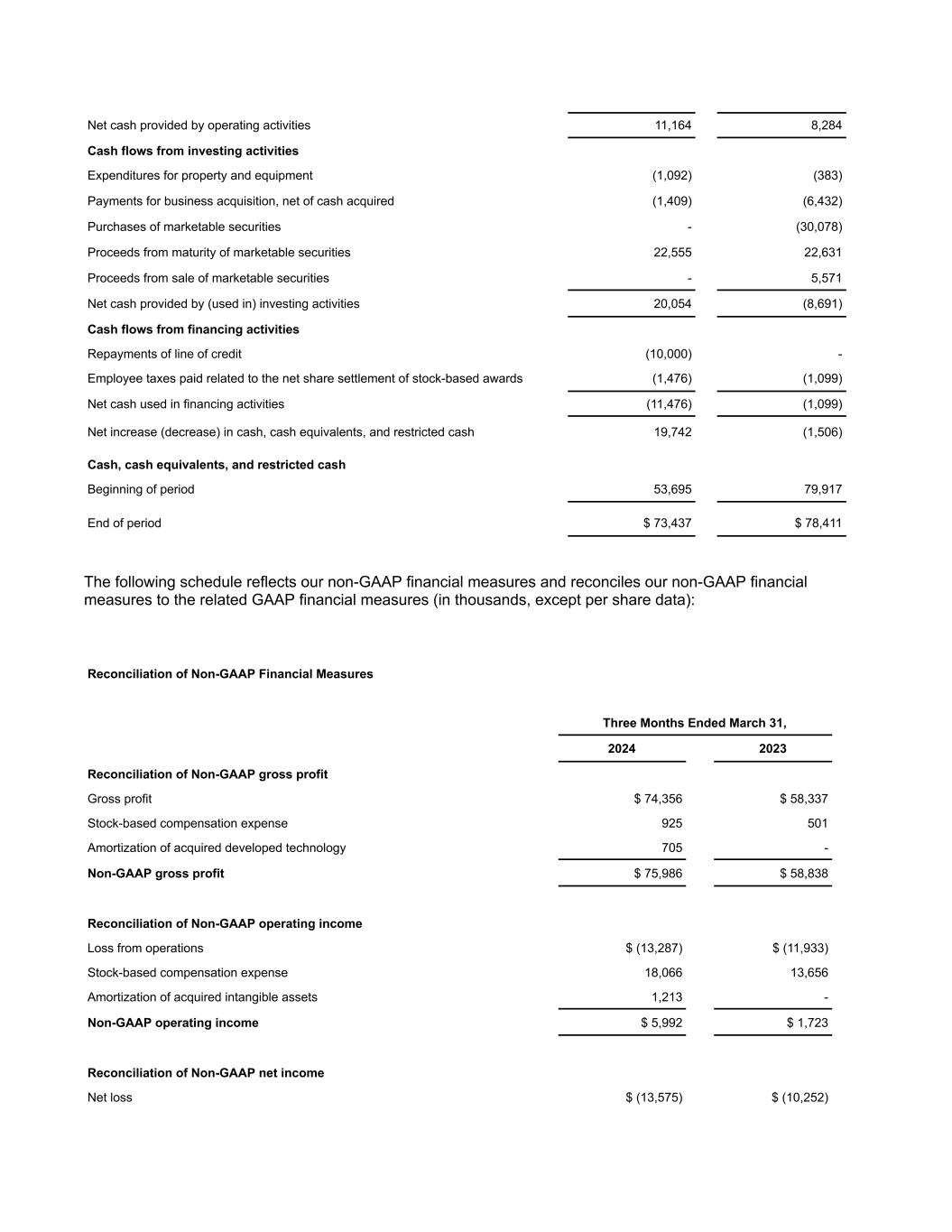
Net cash provided by operating activities 11,164 8,284 Cash flows from investing activities Expenditures for property and equipment (1,092) (383) Payments for business acquisition, net of cash acquired (1,409) (6,432) Purchases of marketable securities - (30,078) Proceeds from maturity of marketable securities 22,555 22,631 Proceeds from sale of marketable securities - 5,571 Net cash provided by (used in) investing activities 20,054 (8,691) Cash flows from financing activities Repayments of line of credit (10,000) - Employee taxes paid related to the net share settlement of stock-based awards (1,476) (1,099) Net cash used in financing activities (11,476) (1,099) Net increase (decrease) in cash, cash equivalents, and restricted cash 19,742 (1,506) Cash, cash equivalents, and restricted cash Beginning of period 53,695 79,917 End of period $ 73,437 $ 78,411 The following schedule reflects our non-GAAP financial measures and reconciles our non-GAAP financial measures to the related GAAP financial measures (in thousands, except per share data): Reconciliation of Non-GAAP Financial Measures Three Months Ended March 31, 2024 2023 Reconciliation of Non-GAAP gross profit Gross profit $ 74,356 $ 58,337 Stock-based compensation expense 925 501 Amortization of acquired developed technology 705 - Non-GAAP gross profit $ 75,986 $ 58,838 Reconciliation of Non-GAAP operating income Loss from operations $ (13,287) $ (11,933) Stock-based compensation expense 18,066 13,656 Amortization of acquired intangible assets 1,213 - Non-GAAP operating income $ 5,992 $ 1,723 Reconciliation of Non-GAAP net income Net loss $ (13,575) $ (10,252)
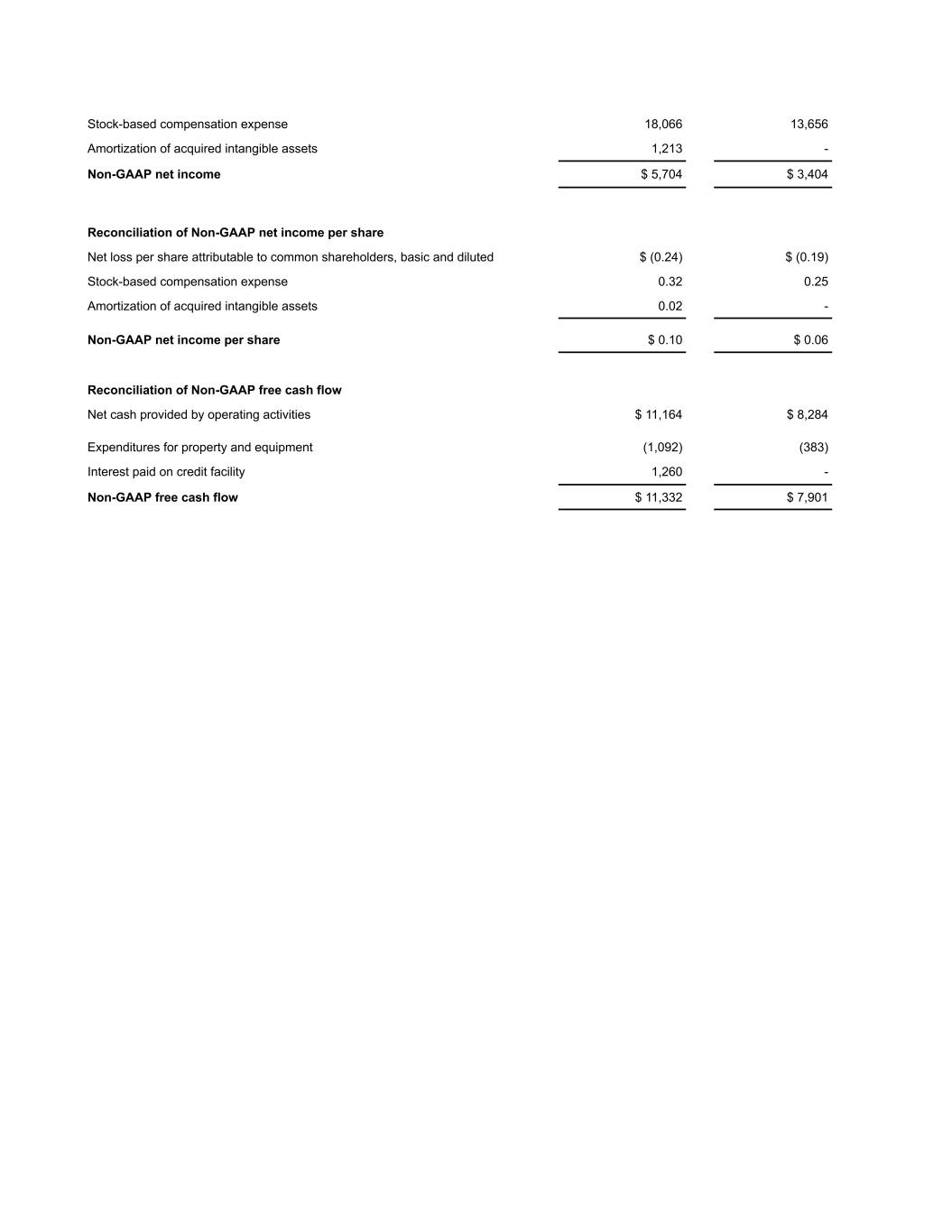
Stock-based compensation expense 18,066 13,656 Amortization of acquired intangible assets 1,213 - Non-GAAP net income $ 5,704 $ 3,404 Reconciliation of Non-GAAP net income per share Net loss per share attributable to common shareholders, basic and diluted $ (0.24) $ (0.19) Stock-based compensation expense 0.32 0.25 Amortization of acquired intangible assets 0.02 - Non-GAAP net income per share $ 0.10 $ 0.06 Reconciliation of Non-GAAP free cash flow Net cash provided by operating activities $ 11,164 $ 8,284 Expenditures for property and equipment (1,092) (383) Interest paid on credit facility 1,260 - Non-GAAP free cash flow $ 11,332 $ 7,901












